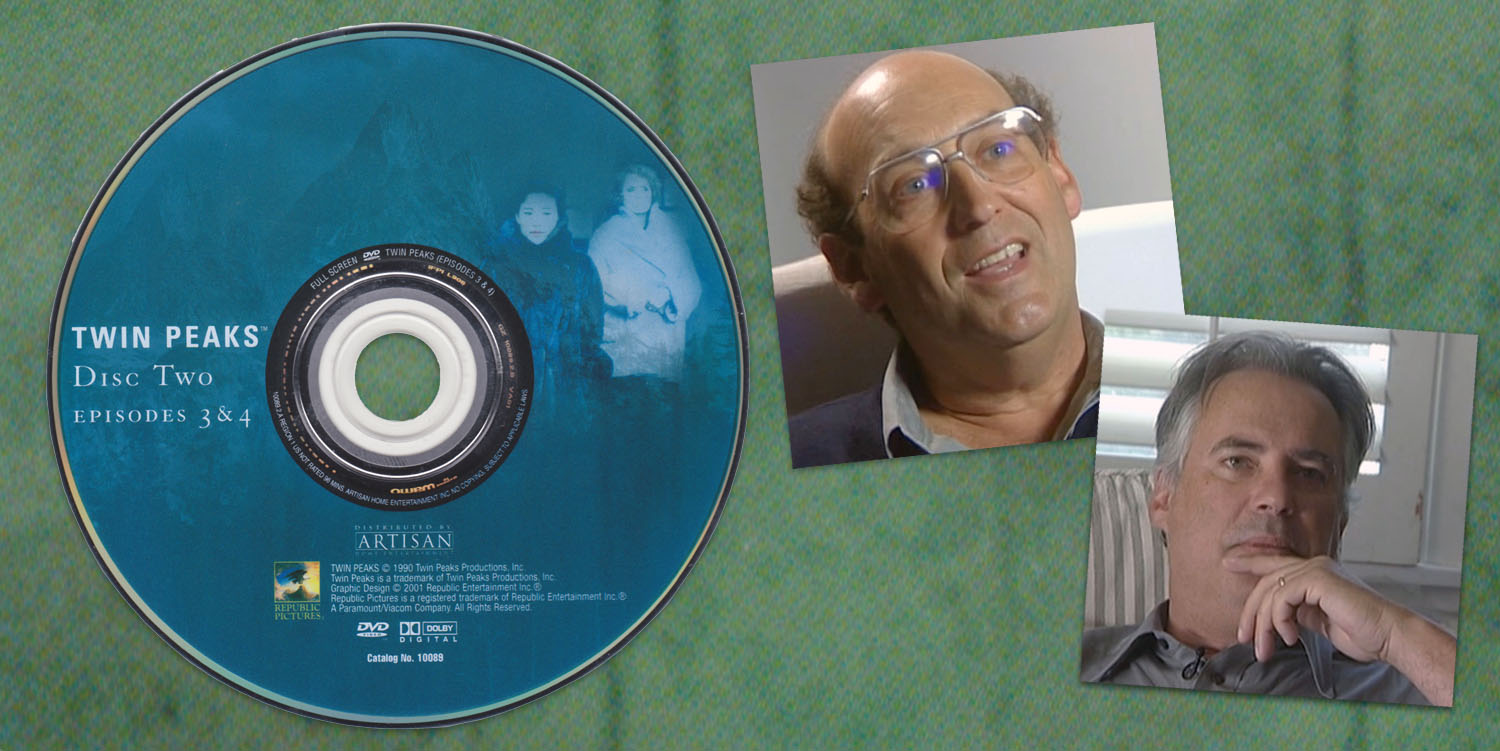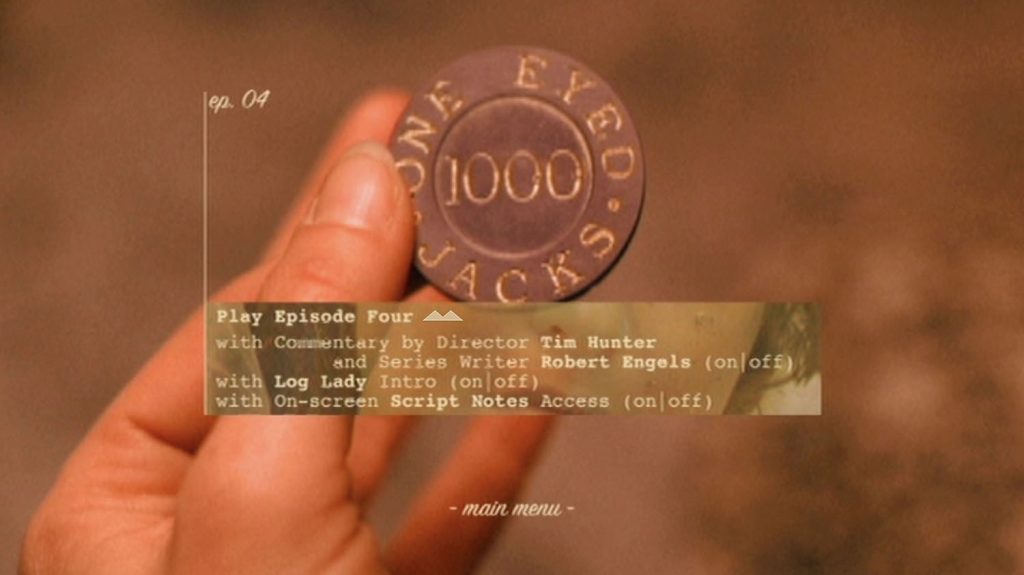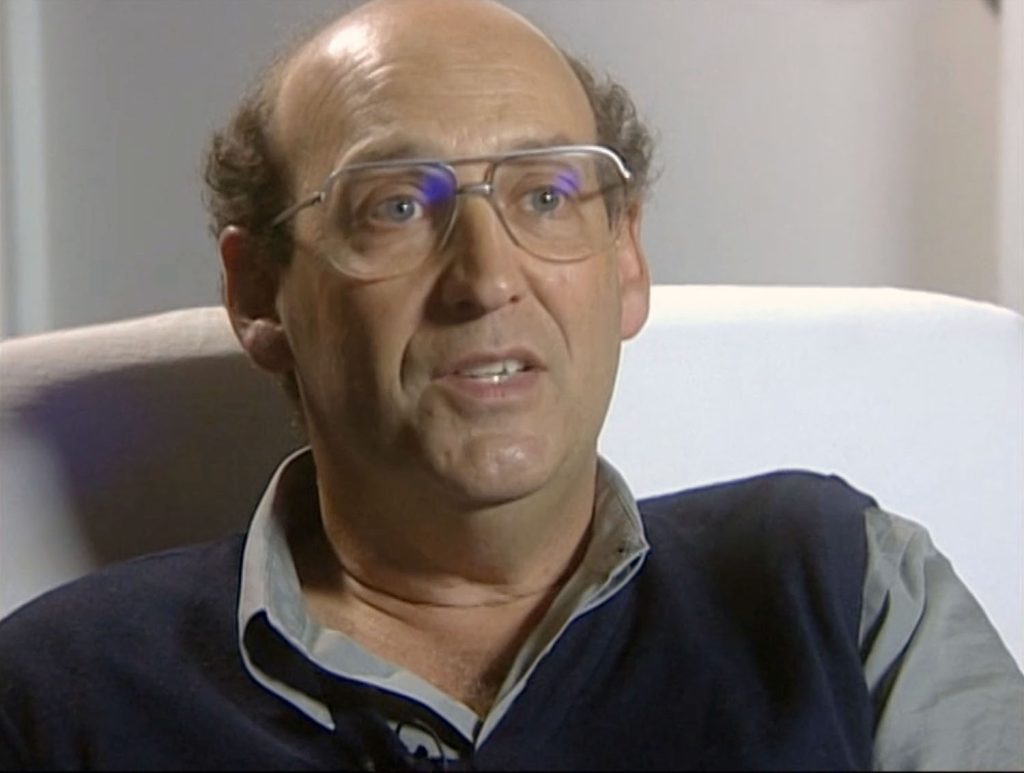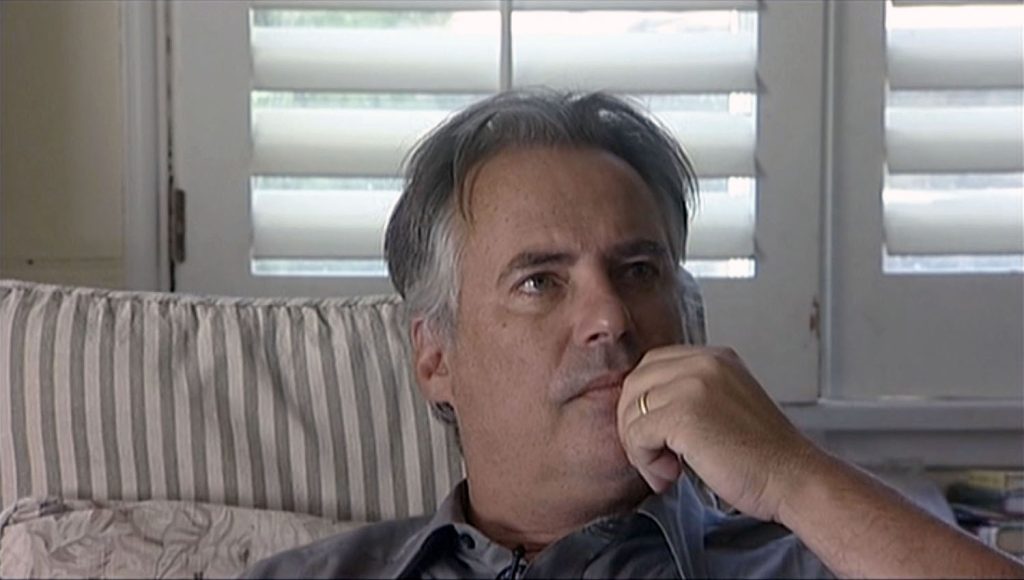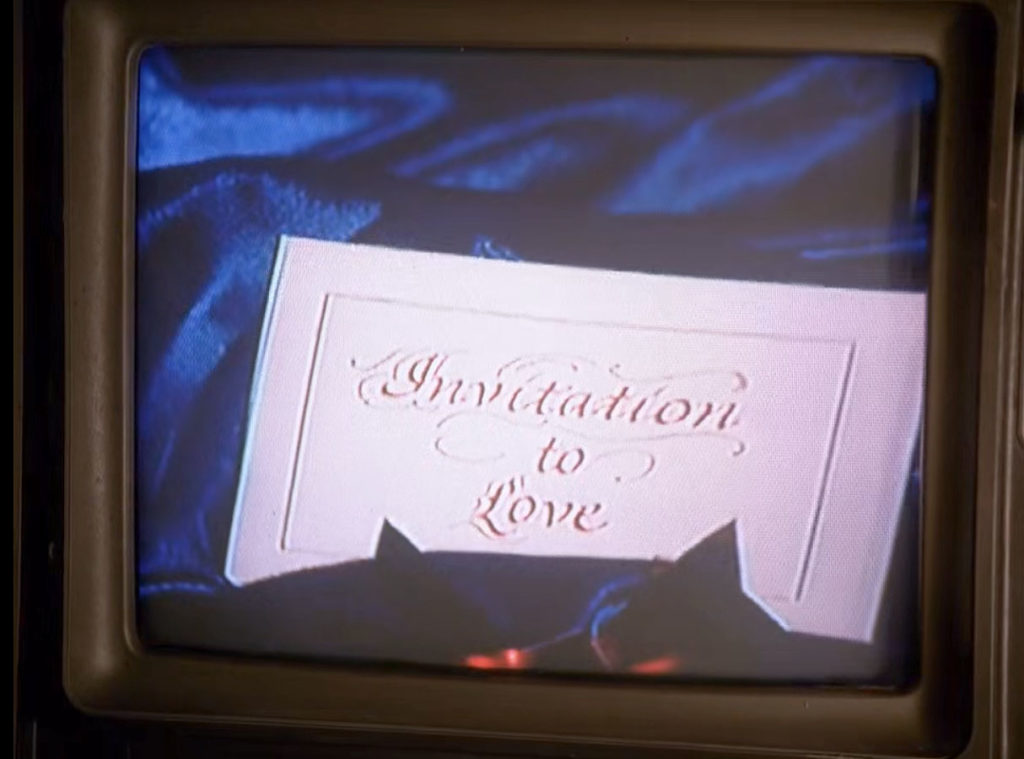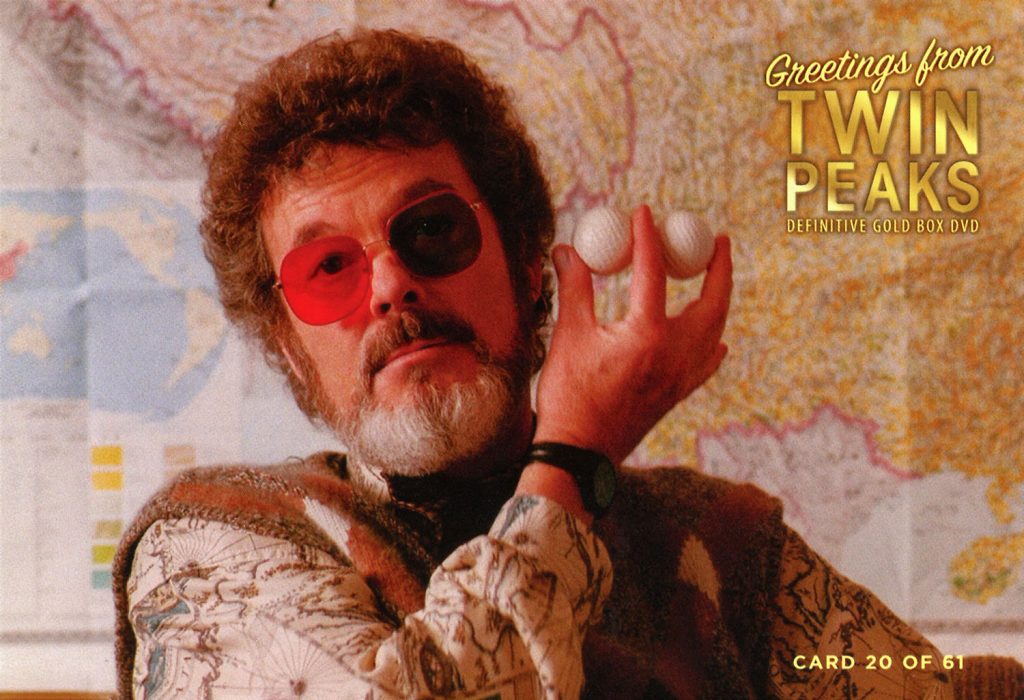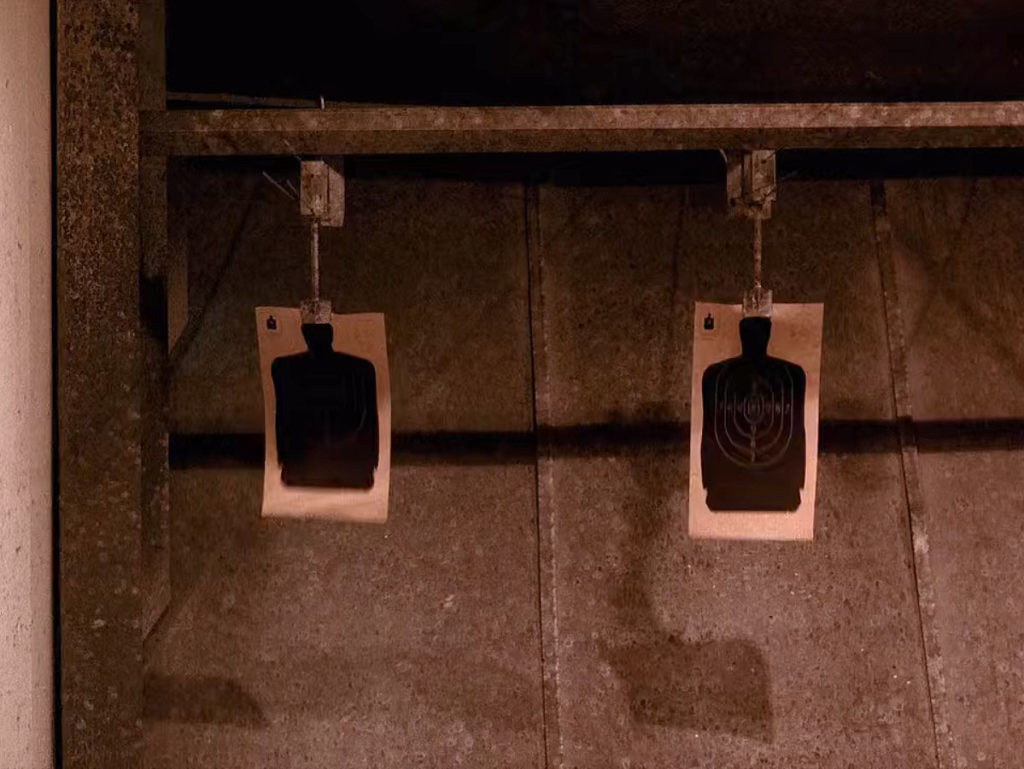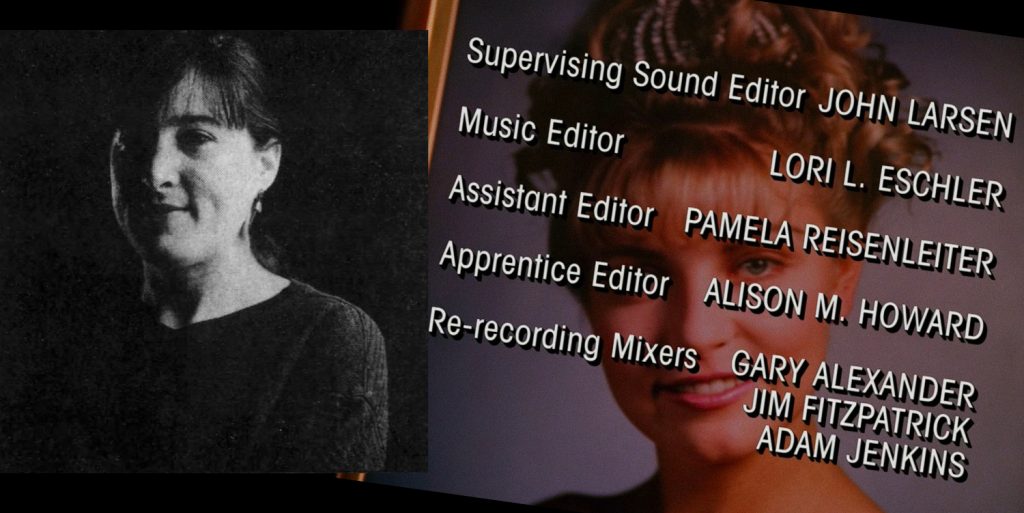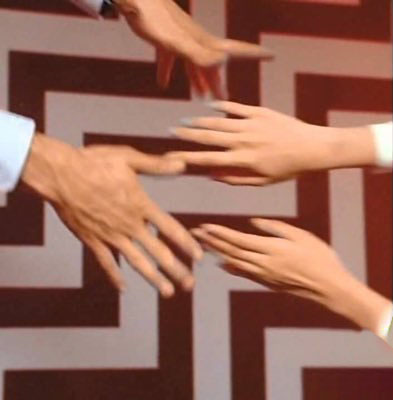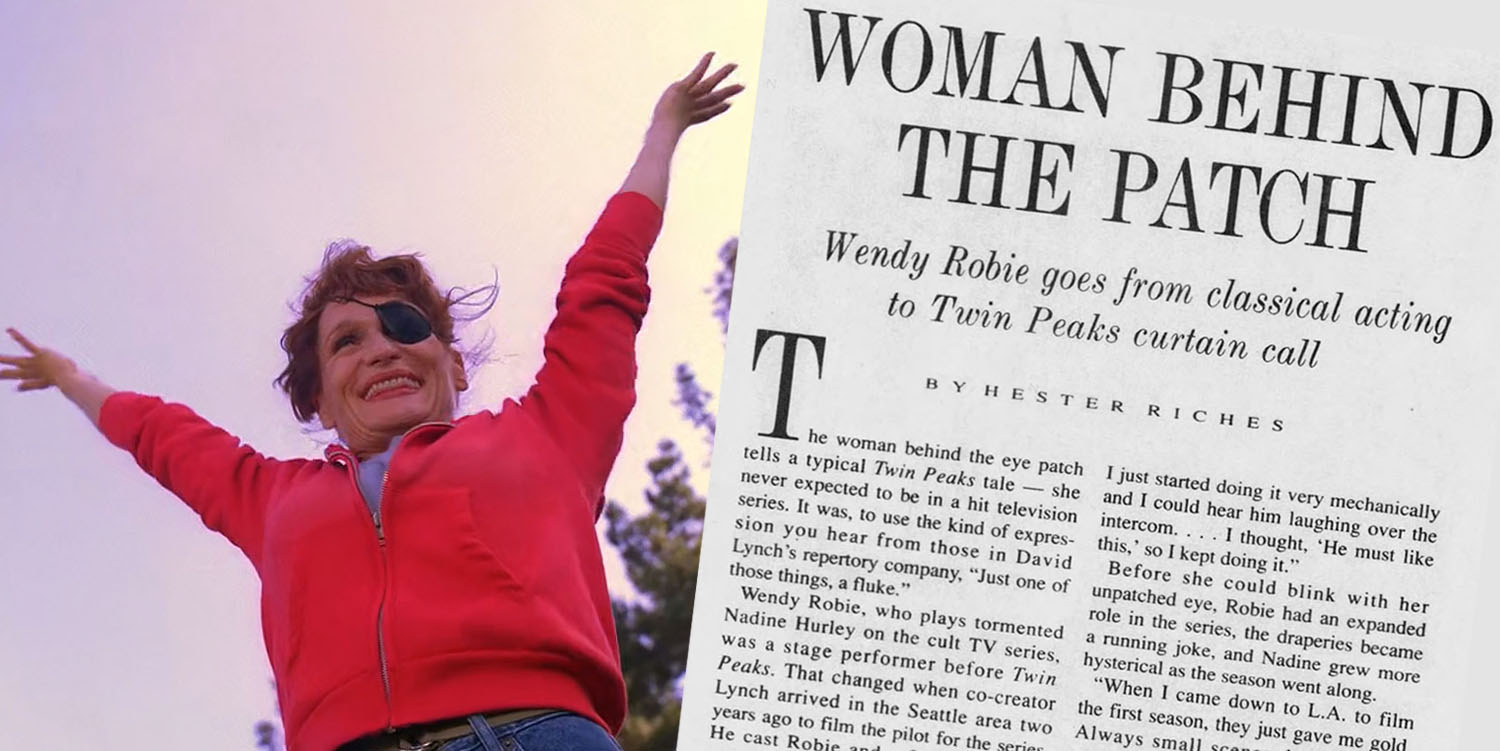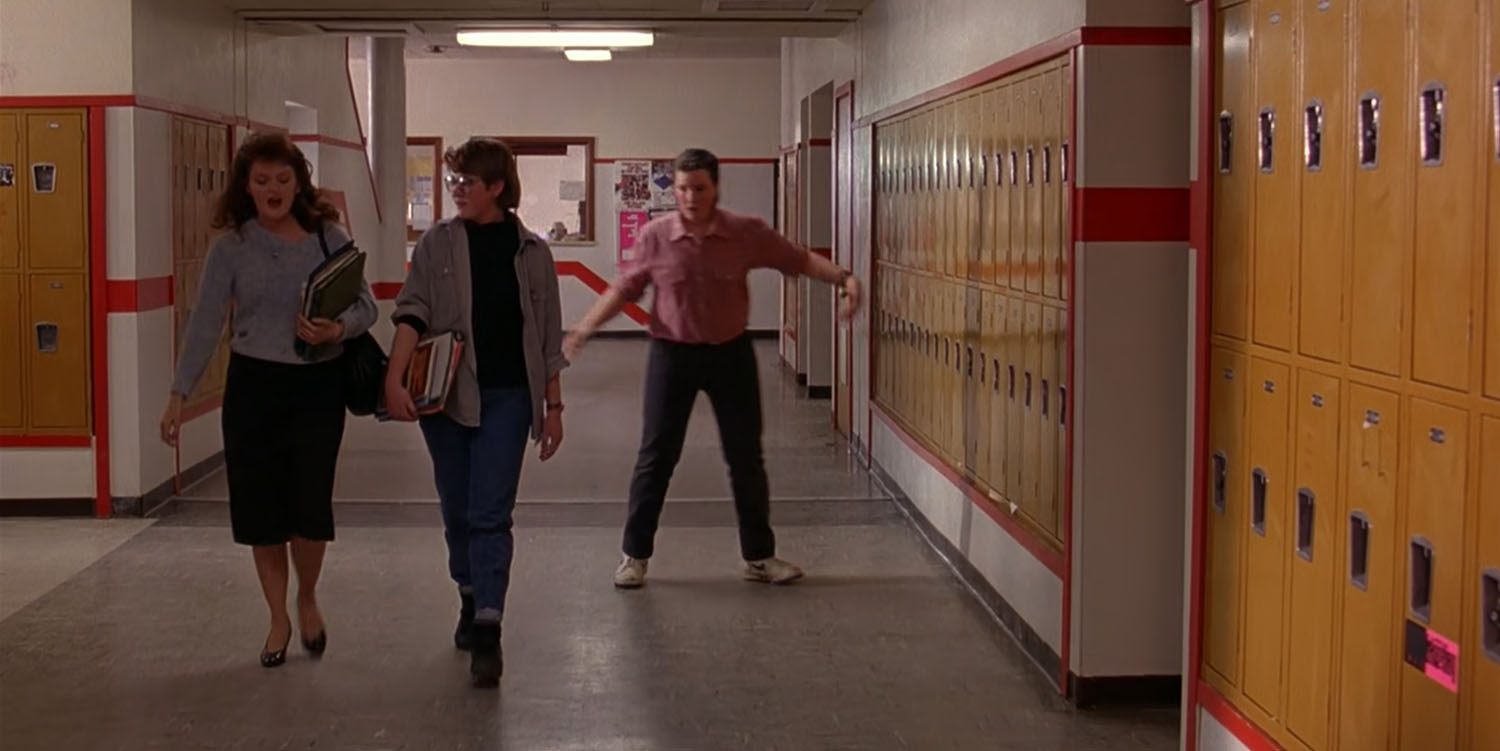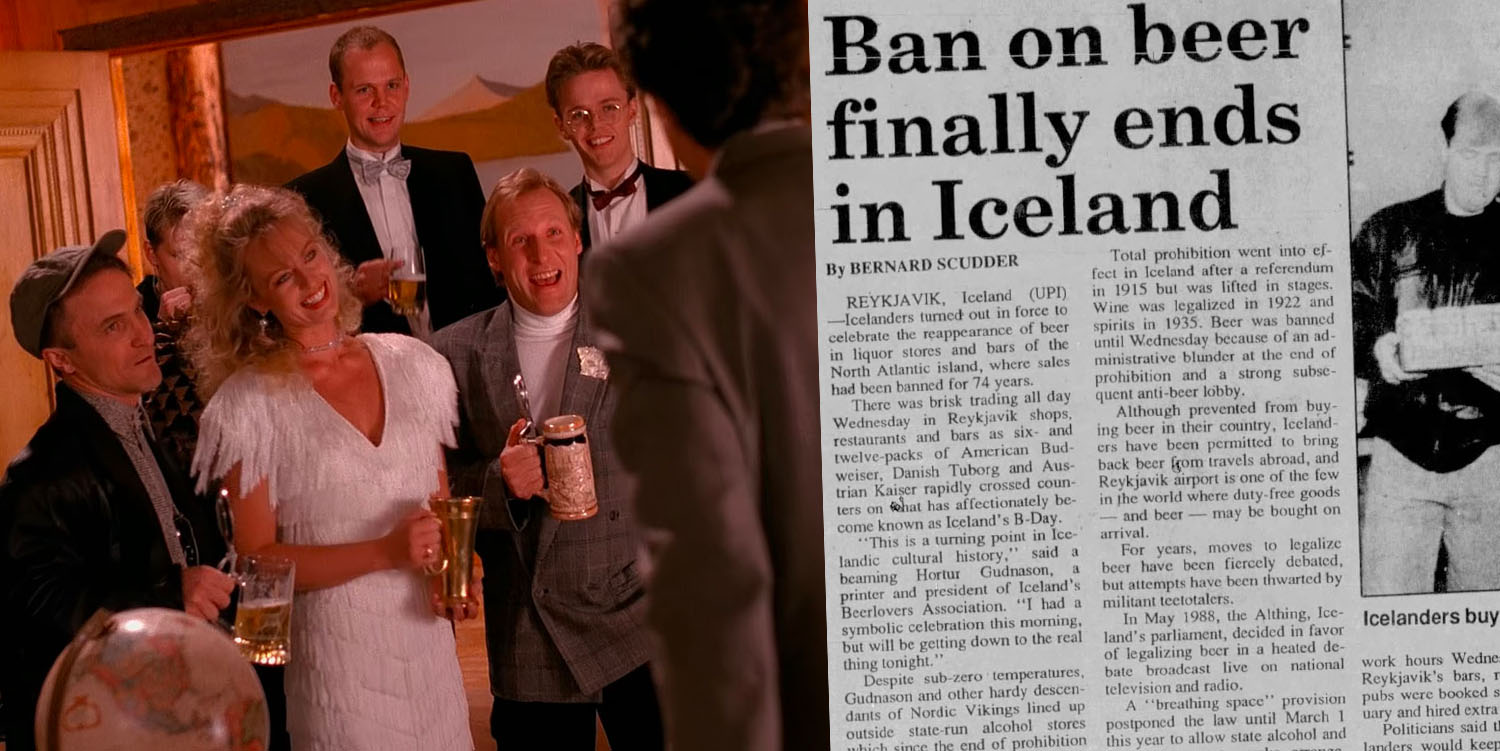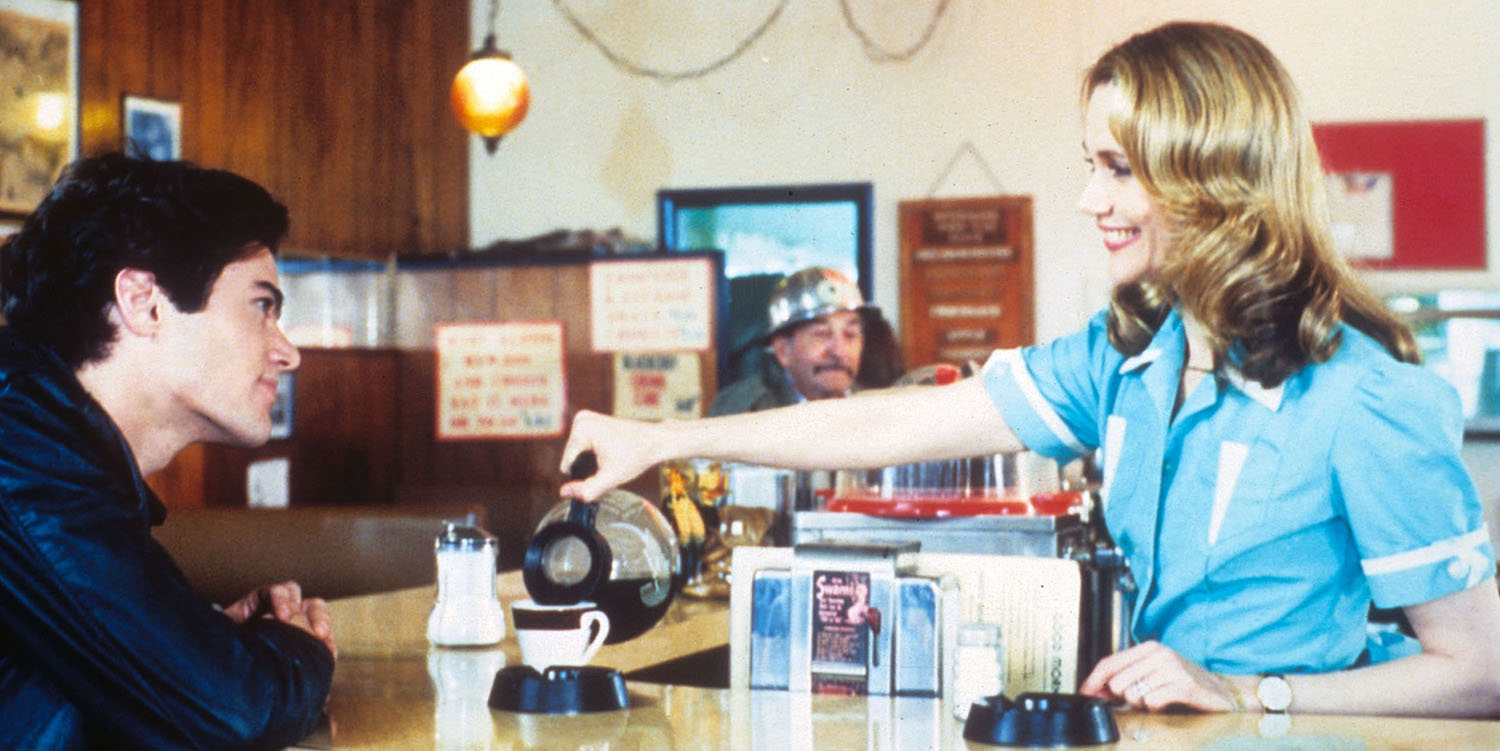For Twin Peaks episode 1.004, director Tim Hunter and writer and series co-producer Bob Engles shared their experiences working on David Lynch and Mark Frost’s show in audio commentary found on an Artisan Home Entertainment DVD set from December 2001. This is the latest article in a series of stories containing transcripts from this now out-of-print set.
TWIN PEAKS EPISODE 1.004 AUDIO COMMENTARY BY TIM HUNTER AND BOB ENGLES
The audio commentary from Tim Hunter and Bob Engles is found under the “Episode Features” tab after selecting “Ep. 4” from the Disc Two DVD Menu.
[Voiceover from Michael J. Anderson plays over the “Previously on Twin Peaks” montage]
The director of the fourth episode is Tim Hunter, the director of many films including River’s Edge. Writer Robert [Bob] Engels joins him on this commentary. Tim Hunter.
[Tim Hunter] I directed River’s Edge and I knew David Lynch somewhat from the early years of the American Film Institute. So when he and Mark Frost set the series up, they asked me fairly early on if I would come in and, and do one, and I guess I was ripe for it. At that point, I had done a few TV episodes by way of making a living in Hollywood, and enjoyed it very much, because I think when I was growing up, I really liked TV episodes.
And that was to me, TV episodes is what television is sort of best all about. So, anyway, I was excited to work with them and they gave me a, cassette of the pilot, which was fantastic. So I got very excited and Twin Peaks is something that I and other directors who worked on it, I think will always remember because Mark and David just gave us so much freedom within the confines of the script and the confines of a schedule that was much less confined than most episodic television has become in recent years.
We really were encouraged to, to do as much as we could with it. So this episode, for that accompanies this, I think I will always remember as the llama episode because there was a scene in the script in a vet’s office, and I’d been driving through Topanga Canyon that weekend and seeing llamas in people’s backyards. So I went to them and said, well, can you get me a llama?
And I showed up on the set and there was the llama. So Twin Peaks was the show where actually you could ask somebody to get you a llama, go out and get you a llama, and they would actually do it without blinking. It’s one of those unforgettable directorial experiences, you know.
[Bob Engles] I’m Bob Engels, I wrote episode four of Twin Peaks and subsequently became a producer on the show and wrote or co-wrote 15 of the episodes throughout the series.
Before I wrote Twin Peaks, I had done a documentary on Michael Jackson that was from the documentary world, and before that I had directed plays in New York and acted in New York. And I had written some pretty terrible but funny screenplays. And I can remember Mark Frost saying to me, you know, this this series is going to be so kind of weird you’ll you’ll probably be able to do this one.
But no, I happened to this is at the same time I was doing this. I was doing Wiseguy on television so which is mainline crime.
We could outline some of these episodes. I mean, there was a master plan in play, but we would outline an episode in in hours and hours and then and then you would you write it and then we would, we would adjust, but we would do those stories and hours. Mark was that facile at where, you know, where the plotting should go. Whereas in other shows, man, you sometimes you sit in a room for days and then you go to lunch and they say, let’s forget about it and you come back. Mark could go boom, boom, boom.
And David can too, they just it’s a trust in a great instinct of this, this and this and this. Okay. It’s this. And then, you know, that’s you wouldn’t go back and move around and adjust. But the literally the okay, let’s do episode five now. And sitting down, that’s, that’s an afternoon at the most.
The idea the soap opera was to make the town seem even more unique, that they would all be watching this show that no one else in America could see. But the what happened was that it seemed to parallel our own plot more, and also seemed to sort of comment on the show more. And I think that’s what David felt was that it was too much making fun of what we were trying to do. So working so hard to make work smoothly.
And it would be easy to say, well, the soap opera within the soap opera is making fun of what we’re doing. You know, it’s getting hard to talk about overkill of Twin Peaks, but in that sense, I think it was too much into, and too close, too dead on, too much saying this is exactly what we think. David would prefer people to see it and make their own their own judgment.
[Tim Hunter] What was exciting about it was coming into a show and realizing that they had cast Russ Tamblyn and Richard Beymer. You know, who all of us knew from their work as young actors in the 50s and 60s, and none of us had hardly ever seen in between.
Tamblyn and Beymer were perfectly cast in these parts, and they just loved it. It was really fun to work with those guys, and Tamblyn was just having a ball, as far as I can remember. Just off in his own space and just having a great time.
I don’t remember where the scuffle magician gag came from. I think it was just something that he said he could do and wanted to know if I wanted to use it. And and I said, fine. I mean, just have, you know, the kind of elementary mise-en-scène that I was dealing with in a scene like this was just to be presented with a scene in the set and realizing that I could shoot it across that big, long conference table in long shots.
You know, when the scenes are are written as concisely as these are. And when there’s so much fun in the writing the dialog may refer to the plot. But the subtext is so rich and just the tone of it is so, so skewed in a subtle way, it really does liberate you to, to come up with less conventional or at least, you know, interesting ways of doing things. And all the directors found that and we were really encouraged by Mark and David, who just wanted us to make the most of it that we possibly could, whatever that was.
And, and I remember in this episode, you know, just wanting to, to arrive at a very precise style. And then I just, I just loved designing scenes in this because the style on a Twin Peaks had to be very, very deliberate, very well considered because the material was that way, you know, everything, every line, you know, could be judged in terms of its impact.
Was it funny? Did it advance the plot? You know, was it, did it signify something else? Did it have a double meaning in some way? And so the, I think the you know, I wanted the, my style to also be very precise and I don’t think I’ve, I just remember framing and composing stuff very carefully and in Twin Peaks episodes

You know, directing television is there’s always an element of it that’s a question of boiling a scene down to to its least number of shots, its bottom line components, you know. How can you do it in the simplest possible way so that you can make the schedule? So it’s often a question of creating setups that will shift into other setups or encompass action, you know, for a long period of time.
It’s not so much just a question of shooting a master and then shooting a bunch of coverage for it. On Twin Peaks, I think we all really tried to design setups that, that kept the scene going and, and marked the story and emotional shifts in the scene.
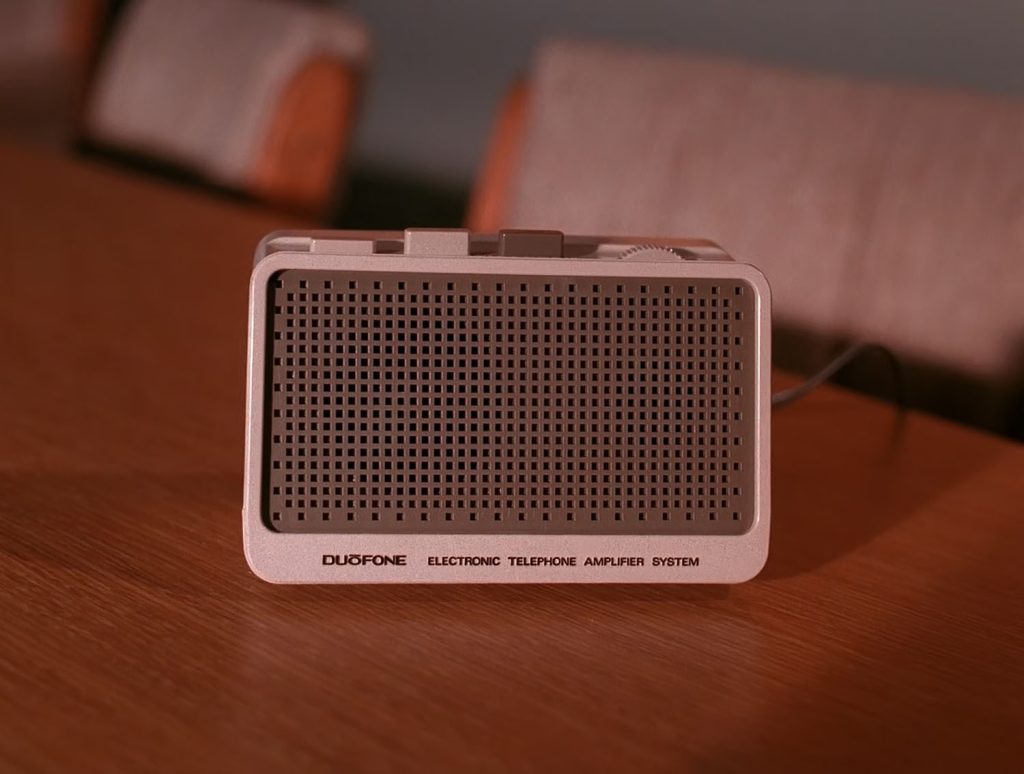
[Bob Engles] Gordon Cole is in this. That’s David’s voice. I think he liked talking loud. And then it came, it worked backwards from there that if he was loud, that it would be sort of that cliché, hard of hearing joke. And then my mother was almost deaf. So I did a lot of, the lot of the writing for Gordon Cole is mine because it’s, you know, Gordon Cole says, what is it? And give me the Glad Hand and all that stuff. That’s all from my mom.
I think it’s when he showed up the day he was going to do it, he decided to be hard of hearing, you know, and it was also so that I think a lot of it was to that so that he could, you know, hard of hearing people have to sound words out. I think that was part of it, too, because that’s the whole thing of the “Chi-wow-wow.” But in this we did don’t know; he was not hard of hearing here. And a lot of it is there, there’s lots of exposition. And for that, we go through real quickly. And I think that it’s it’s David just trying to get that information out as clearly, succinctly, loudly as possible.
So that’s probably where the heard of hearing came from, is that, you know, in David’s mind had already been established that this person talked loud and quickly. So it’s a small jump to get that a person just talks because he doesn’t listen anyway, you know, sort of thing. They might have decided that, but we certainly didn’t, we weren’t writing for a hard of hearing person.
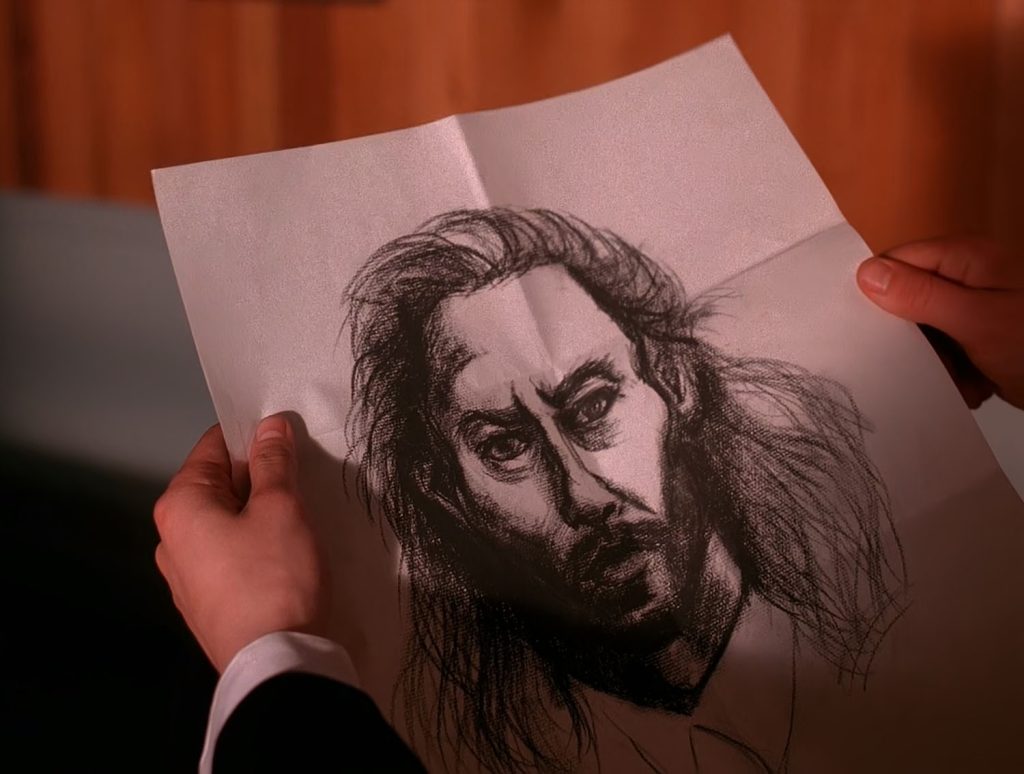
[Tim Hunter] One of the good things about doing TV episodes is that you direct the hand that’s dealt you, basically the script you’re given and you don’t usually have very much input in it. And for me, that can be a plus. It’s very liberating in a way, or at least it allows one to concentrate on how to best bring it to life with as much style as you can under the circumstances. In the circumstances is almost always a very tight schedule in a television series.

In this case, I had absolutely no idea what the plot was about. I mean, there’s so much plot in it. Twin Peaks is just full of plot. Almost every scene is, is an expository plot scene, and that’s kind of miraculous, in a way, to have a show that had so much plot on the one hand, but the plot actually mattering so little because the subtext of the scenes is almost everything in Twin Peaks.
I think it’s struck a very unique balance that way. And it juggled an enormous ensemble cast of characters for a TV series nowadays. It was a very, very large cast, and so the scenes, by necessity, were quite short and they were very incisively written. And, Bob Engles wrote this episode, and for me, he was the best of the staff writers after Mark and, and David. He wrote very compact scenes that were very to the point, and they were funny without ever going over the top.
And of course, the, you know, people think of Twin Peaks now as this cult show that had its tongue in it’s cheek or hit a certain balance between, black humor and reality and realism and surrealism. But the trick on Twin Peaks and many things like this, I think, is always to play it as close to the vest as possible. And, and really pick your shots when you want something to be deliberately funnier. You know, outlandish.
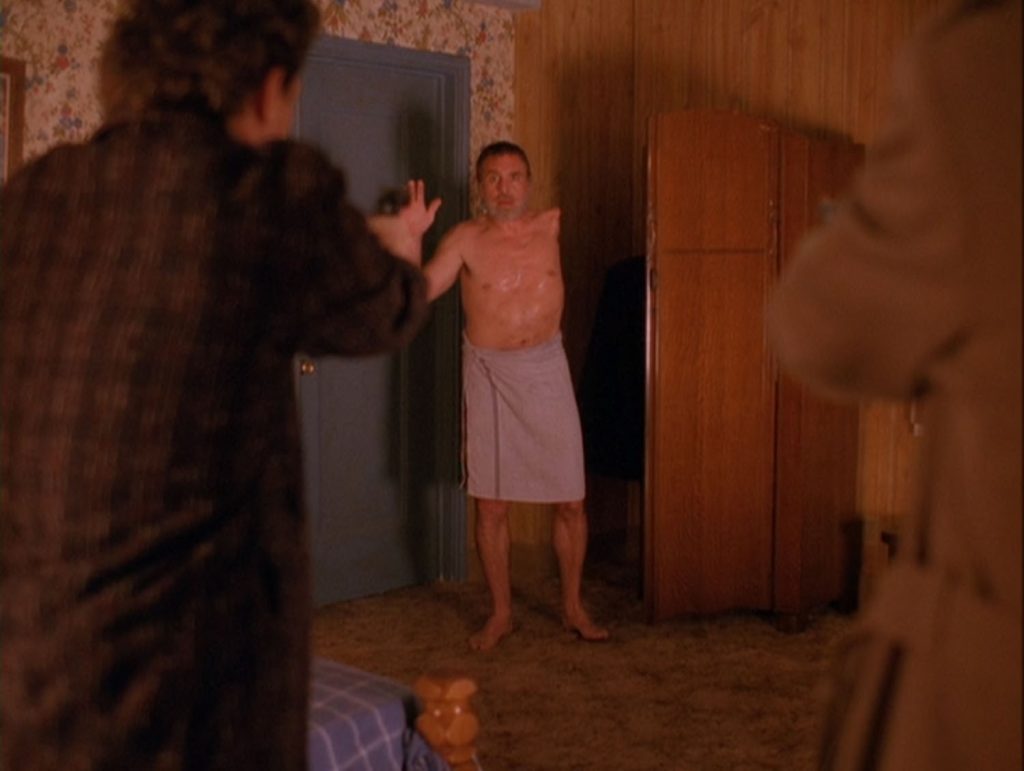
Yeah. I remember when we did this, we were all very conscious of the fact that nobody had ever really shown a one armed guy without a shirt on, and we asked permission. I asked permission, I asked everybody, you know, can I do this? And they said, oh, yeah, yeah, sure. Absolutely. I don’t think they did it in the previous episode that introduced him. And of course, Al Strobel who plays it, was dying to take his shirt off. He thought it was a great idea. And it was really a question of, you know, sort of one armed man’s rights, you know, that, that he could he could do it, do the show that is, without a shirt on.
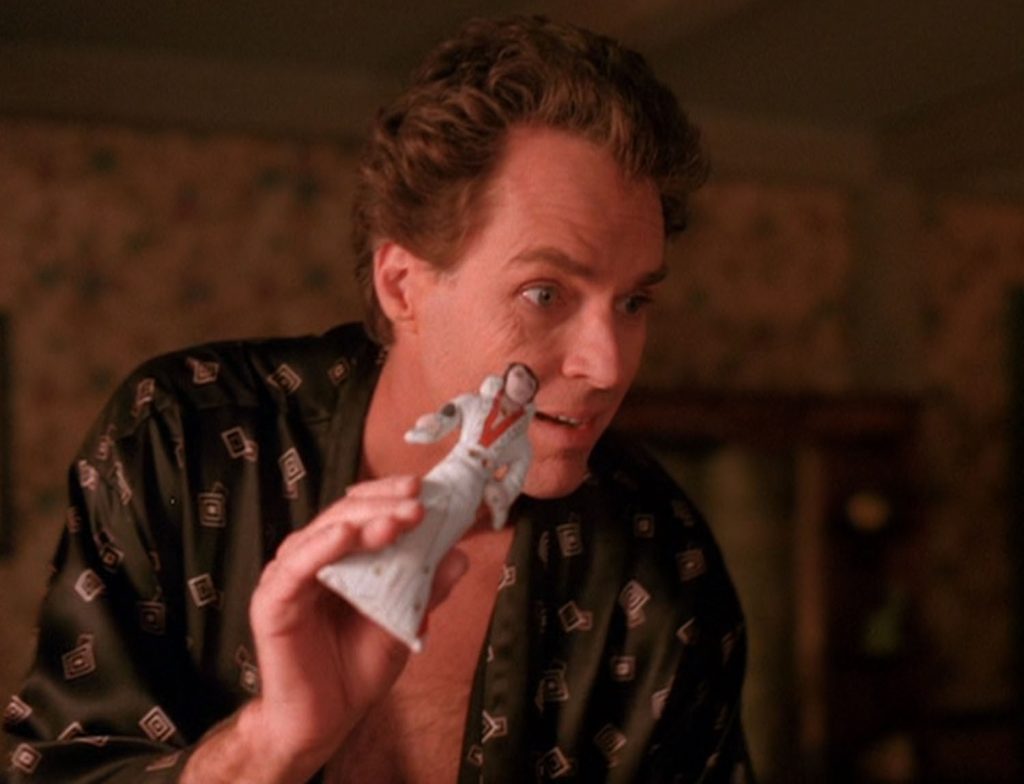
[Bob Engles] A little Elvis is, you know, is that’s what Elvis called his penis, his manhood. And, there was some sort of discussion with Standards and Practices that we could say that and that everyone would know exactly what he meant if he said, “I’m going to go wash my little Elvis.”
So we got a little Elvis image for him. So I don’t know who came up with a little Elvis doll, but it’s just, you know, that it’s like becomes part of, you know, Twin Peaks mythology holds up a little Elvis, and he’s clearly, the line is the other way. It’s it’s the loudest, you know, he’s going to wash off. But that was to go around Standards and Practices. It came out stupid but that’s completely what it is. It was just a dispute over the language so that if he held up a doll, we could always say, well, no, he’s washing on this doll.
TWIN PEAKS – EPISODE 1.004 – ACT TWO COMMENTARY

We wanted to have a one armed man because everybody, we all love The Fugitive. The Fugitive, Wild, Wild West and Mayberry are the three that everybody that worked on there, everybody loved those three shows. And you can see, you can see influences of all three of those shows over and over again. From you know, Michael Dunn’s character in The Wild, Wild West, Dr. Loveless, you know, to ours from the one armed man, the fact that it’s an ongoing story.
And Mayberry from you know, that’s that’s the Sheriff’s Department. You know, that’s what’s so charming about those, you know, you know, Deputy Andy and kinds of just so and the pace they go at is so much like Mayberry. Those are the big, the big influences.
And obviously the other one is the atmosphere in the naming of characters. Those are all noir names, which was fun to do it. You know lots of them we already knew – the Lydecker, but other ones we had in a Noir book. You know, everybody had to do Noir research and we’d always try to find find stuff. But Gordon Cole is a Noir name.
And, you know, and for a while the motel in this episode was called the Noir Motel. Now I don’t, that’s too much. Now we’re tipping it. But people, people got that pretty quickly. Not that that was such a clever thing, but it was. You could see that there were, you know, and Laura from Laura the movie Laura.

[Tim Hunter] This scene is an example of, it’s very, very precisely built in terms of set ups. I’m a big [Douglas] Sirk fan, of course, so I was using the mirrors in the bathroom. I remember being whenever I see a mirror, I think of Sirk, and there’s nothing much I can do about it. And I set this up idea so that they’re reflected in the mirror.
And then Richard Hoover did these wonderful Twin Peaks diagonals across the thing. And I think that I must have asked him to do something like this. This was a set, it’s Caligari-like. So all the angles are very, very precise in this scene because
[Bob Engles] The girls or the teenagers. I think that’s at the heart of the, you know, there’s so much of it. They were so perfectly cast, impeccably cast, and such kind of icons of each thing, from Audrey to they were so secret individual and how they talked and it really connected. I remember thinking that this, this really connected with the audience we had for some reason, I guess it is that that they were wet dreams for lots of people or girlfriends that you wished you’d had.

That’s even even more to the point. The bad girl, the good girl, the you know, the poor, the girl on the wrong side of the tracks. And Audrey had this, Sherilyn Fenn and Lara Flynn Boyle had such a, connected amazingly.
You know, the we had the dance that Audrey does in the to the jukebox all by herself, you know, we had thousands of letters about that. I mean, people just flipped over the simplest thing, you know? But it was like it meant so much, and it it was so it struck people. Is so cool, you know?
And then I think it’s a lot of those things just to even go back to that soap opera idea that, you know, the two girls smoking in the bathroom, it’s so perfect. You know, it’s almost a cliché, except that those, those actresses were so good that they could they could do that, you know.
And, and I think the boys, too, I think the young love was really the heart of it. Even even with older audiences members, they were struck even more so by how the, you know, the teen love. It’s such a no matter how old you become, it is your first love. And all those things are so still so real to you, your first sexual experience. And David and Mark just nailed that.
As the series recedes, people tend to forget that that was really that was really the heart and soul of it was that, you know, in the scene when they’re burying the locket and, you know, all secret love and all those things were just, you know, and then Laura, obviously.

We really were doing following a soap opera structure in the sense that you you know, each act has four scenes and you sort of slowly move them ahead and, you know, deceptively simple.
And I think that’s I often think that’s the key to really cool television shows, is that you take the structure that everybody knows. If you start to screw around with how you’re going to tell the story, then people get, the audience can get very anxious. But if you stay to a structure they know, yeah, they’ll hang in there when when it’s not a normal sort of way of doing things so that you can, you will, they know that they’re going to like the Hank Jennings. He’s going to have his hearing. He has this little scene before his hearing. They’re going to decide on the hearing. And the audience kind of intuitively knows that in this episode, there’s going to be a yes or no, you know, whereas in a daytime soap, that would take months. But in this sense, he’s clearly going to get get out of prison.
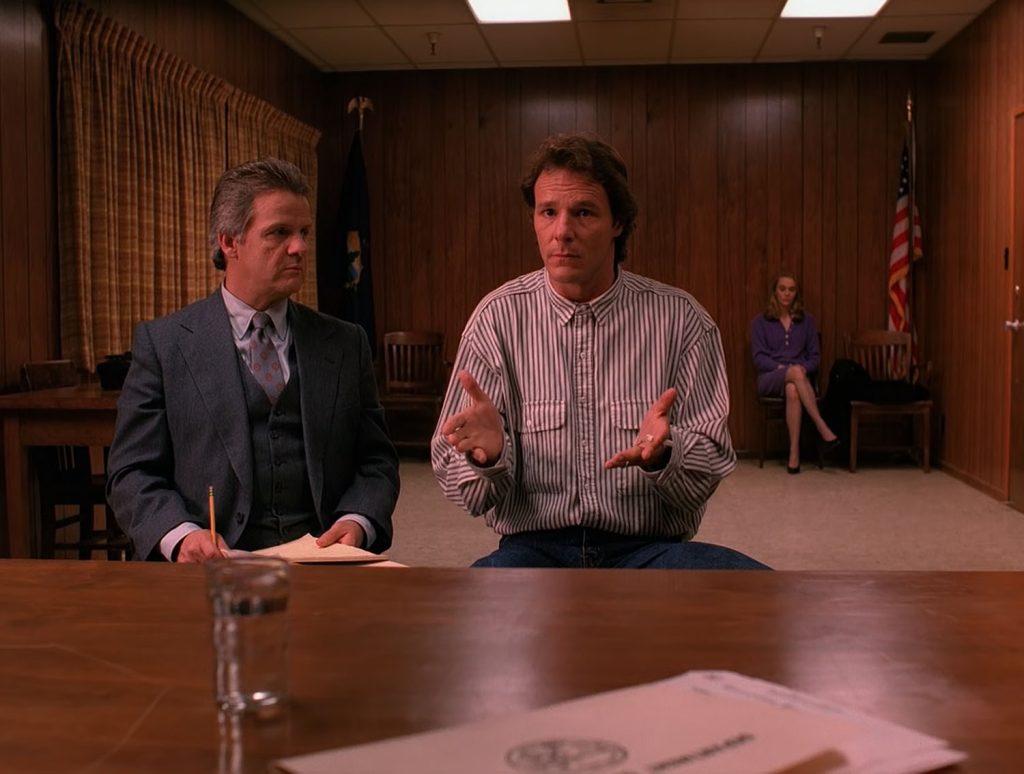
And at the same time, what was, you know, the Twin Peaks branding of that he clearly knew more than he wasn’t who he said he was. So that the other great trick was that, of course, he looks just like a thug. And then at the same time, he’s, as we learned later, he’s using all sorts of other messes and, and like the introduction of the domino and all those things, you know. Those are all right out of, you know, Days of our Lives, except that they’re they’re not, which is which was the most, you know, that was the whole fun of us, that you couldn’t.
That’s what you know, Mark was so great at. He so, as we structured this series and, you know, really Mark and David did the initial and most of the, you know, the heavy lifting there. They it was just so, like ducks in a barrel to write it because you couldn’t get out, you know, the Hank Jennings scene. It had to be he he, you know, his little arc in that episode had to be these four things, and you could load it up because the audience knew, I see how this works.
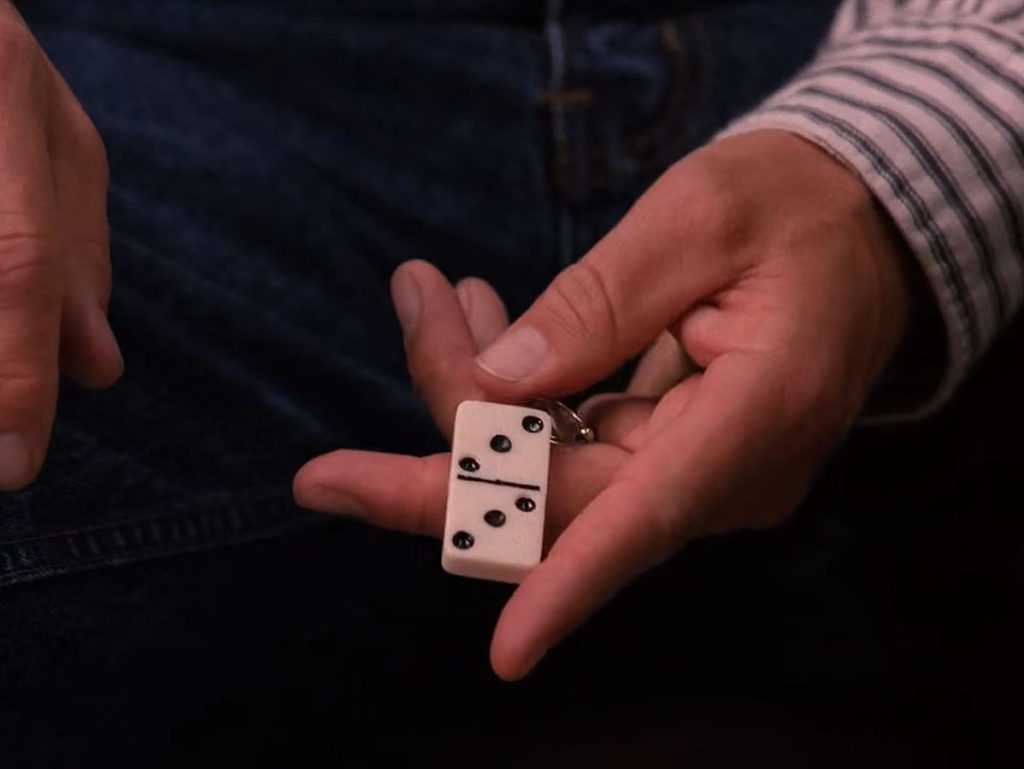
You know, you could take something as normal as the parole hearing, and then by the end of it, you realized he had that domino. And how would how would he get that domino? You can make everything seem more important than than it really was, you know, just so that it became, like I said, that that you you hung in there with the structure because you’ve seen it before.
But at the same time, you know, he clearly knew more than it wasn’t just a parole hearing. And it was an odd place. Again, you know, Tim [Hunter] did such a great job of how weird that parole hearing looks.
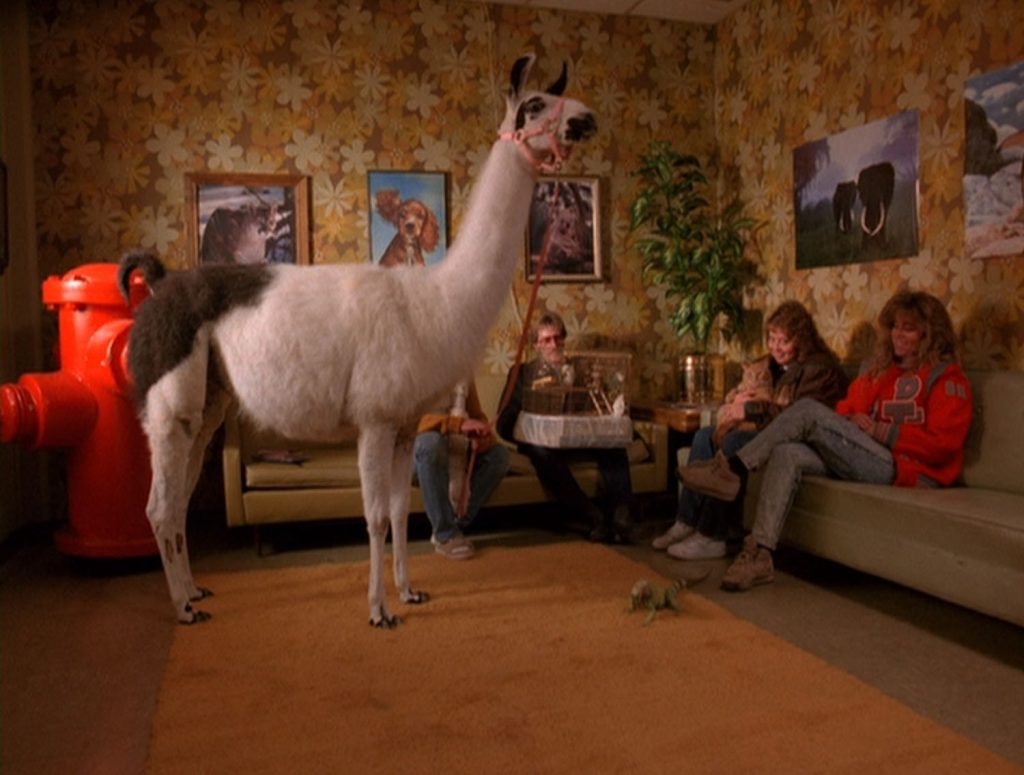
We knew we were going to a veterinarian, you know, and and then I think everybody was nervous because eventually we were going to shoot a parrot. You know, you just have all this television stuff, you know, you can’t kill a parrot. But we knew there was alarm. It was coming, you know, and the llama was not that most, there wasn’t really a talented llama. There could be such a thing.
So, you know, as I recall, when the when the, the llama goes by, Kyle [MacLachlan] is chewing gum. That that’s what the, that’s what the llama smelled. That’s where the llama stopped. Just started on a few little bits I remembered.
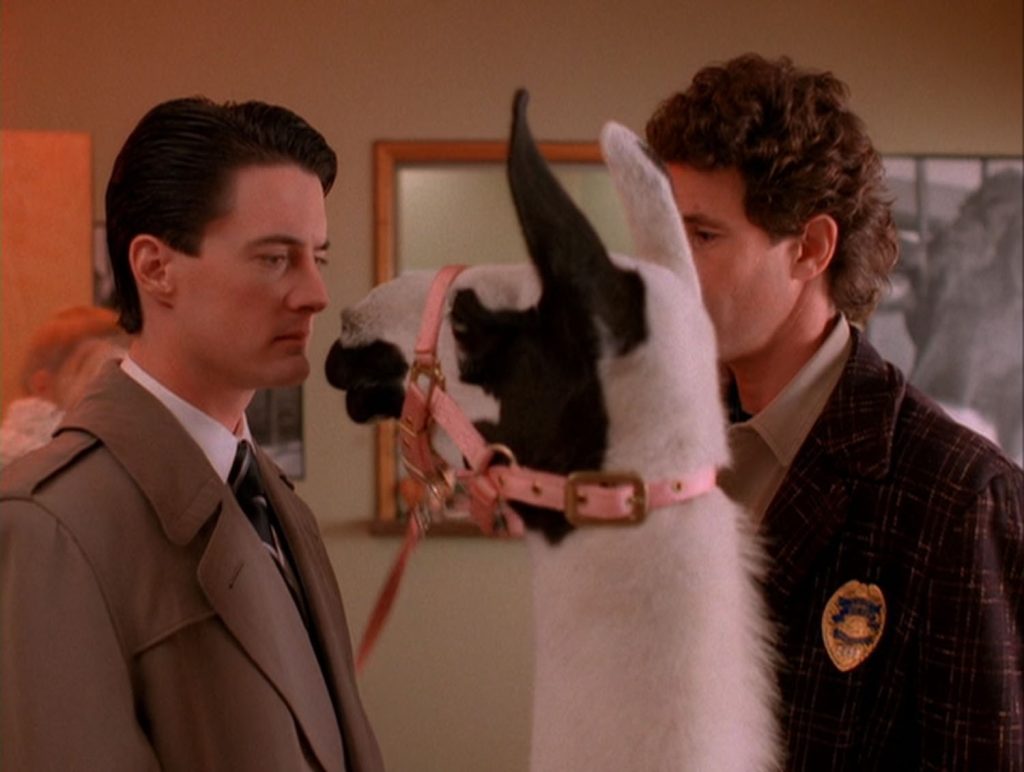
[Tim Hunter] I just told Kyle that I was going to walk the llama through this exchange, and that he should do everything he could to make direct eye contact with the llama. And he did. There’s that little moment there where he and the llama look at each other. Kyle was so straight, you know, never phased him. When you see the llama go by, he’s chewing on something and the llama smells it.
And we only did it once. The llama did it and stopped to look. You know, it looks like he’s looking at him, you know, because that was the idea that Kyle has this extra sensory thing going that even animals know, whereas in reality it’s the sweet smelling.
TWIN PEAKS – EPISODE 1.004 – ACT THREE COMMENTARY

All the girls in the show were great. Lara Flynn Boyle and Mädchen Amick was great in this thing. So I always tried to make these scenes kind of sensual. Whatever I had seen with them, the way I kind of rolled into this scene and then cut to an extreme close up.
So I tried to keep it pretty sexy. All the girls in the show were really had, had a kind of calmness to them which maybe David is responsible for in the casting. Mädchen was great in this part because occasionally she acts a little dumb and she knows, what’s the character always sort of knows what’s going on. She’s very manipulative in a very subtle way.
When you really work with the cast that was as comfortable as this one was, everybody felt that we were, you know, they were, involved in something that was different and, and had a chance to be really great and groundbreaking.

I don’t remember the, the, the arc of the plot particularly well because it was so elaborate. You know, reviewing this episode, I couldn’t tell you what went on before it, or after it. And I can’t say that the plot was trivial either, because I remember when Twin Peaks was on, we were all really caught up in the story, you know, as a good soap melodrama would, would tend to do. It really hooked, hooked its viewers, you know, the plot was of great consequence.
And yet the, you know, the writing still left room for, all this funny, skewed character observation. And there was always room to, you know, to put in the details, you know, like the llama or the golf balls.

[Bob Engles] Watching this episode again, I thought it was a little busy. The whole thing was a little too much. The good thing is, there’s so many cool things that happen in this that happen over within the series that the first time they really come shooting out is here. The downside is that these guys have to be as you plot things out, these guys are sort of running below the surface because we got to get back to them, you know.
They have big things to do farther along, so you have to keep them going. But I think in in one sense there’s a little vamping here, probably. On the other hand, they were every bit as popular. The two boys and with the other girls as they were. But there is some, some sort of in as in any series, you have to keep this going because we’ve got a long way to go to get to Leo and to get Bobby back to where he’s supposed to be. And you got to keep that story going.

[Tim Hunter] Richard Hoover is the production designer who was kind of making his reputation at the time, since has gone on to become a fairly big feature film guy down off Tim Robbins’ pictures. Richard was on this and his art director, Mike Okowita, and they were just great, you know, so they had built all the sets.
Almost the entire series was shot on the on the stage, on the sets that they had built. The police station was a set. The diner was the biggest set. The lodge, the Palmer House living room and interiors, wonderful, wonderful sets. And they were all dressed beautifully with all this funny stuff, you know, that was very evocative.

The ice cream cone sculpture in the diner or the, the swordfish on the wall of the office in the lodge. So I always like to work off that material, work off what I’ve inherited or what I find on the set. And, but, you know, create the shots around that round. I remember looking at this morning and admiring how much of this wood paneling there actually was. I think it gives it such a such a distinct look.
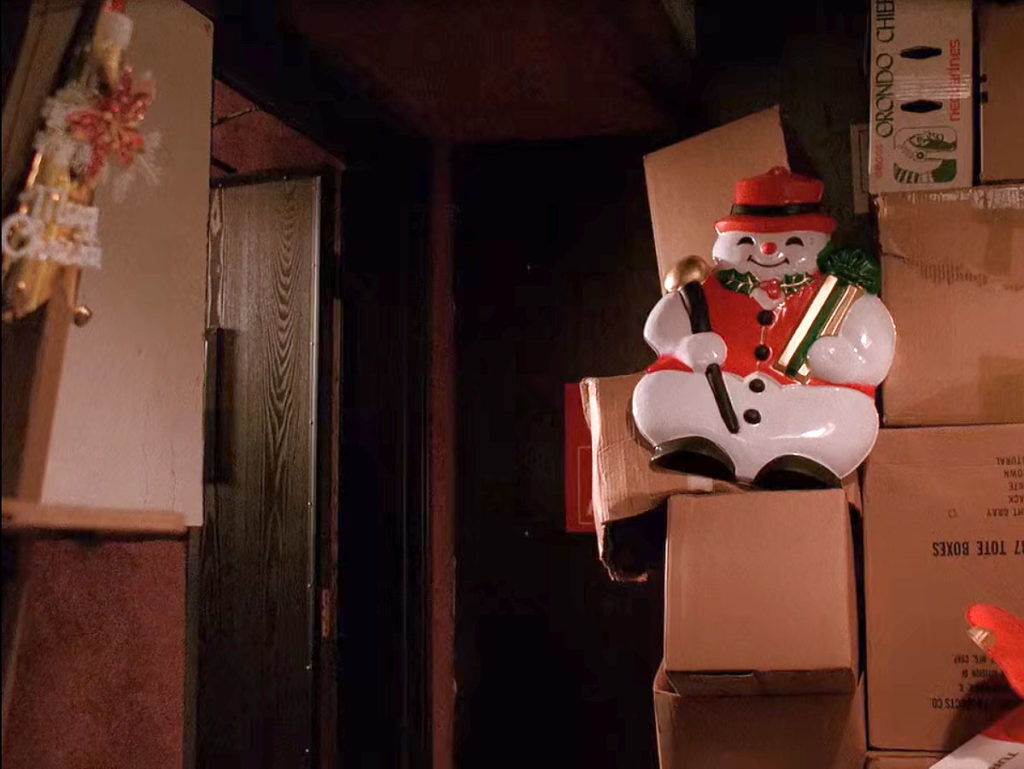
Well, that Okowita putting in all the Christmas decorations on the shooting range. That’s the kind of thing that you could find in Twin Peaks. You know, it really gave you a a hint as to where you could start a shot.
The shooting gallery was Mark’s idea that that stuff was keep pretty close in case it was, it was a little firing range in the valley somewhere near Westlake Village. I guess, where we shot this, they shot a lot of that large exterior type stuff in, Westlake. I think.
I learned to respect actors very early in my career on Tex, my first picture because I somehow I just was very quickly aware of what a difficult job it is to perform the same material, take after take, and keep it emotionally fresh, and respond to a director’s notes and the and the contingencies of whatever production situation there.
And so I developed an early respect for actors and, you know, and I just like to, I like to talk to actors a lot about the character and what the character is thinking. I see my job because I agree with those directors who say that, that a large measure of, of the secret of good acting is in good casting.
If you cast the right people, you don’t have to do a whole lot of directing. So I’ve always felt my job to be just making actors aware of, that much more aware of everything that the character could be thinking or feeling at that point. Just opening up as many options as I can for the actor. So the actor can consider a full range of possibilities of what would be in the character’s mind or how the character might be feeling given the position he’s in.
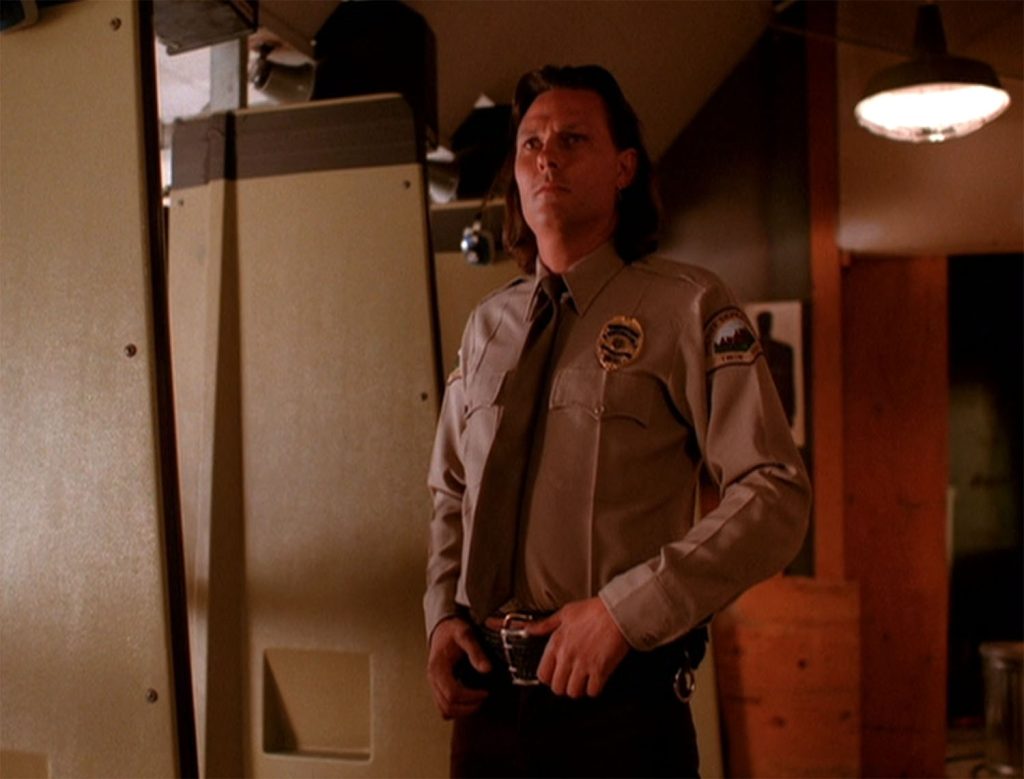
[Bob Engles] There’s one scene, Michael Horse’s poem that he reads that people love. I think it’s I did a draft and worked in there, but it was, you know, I just dashed it off. It’s not. It wasn’t, you know, it’s a very sincere, straightforward. But it’s not something you can spend a lot of time with and, you know, and, and you want to get Michael Horse in the scene, but it’s like all things in Twin Peaks, we never would have him.
It should, you know, the choice in writing that was always to give him something that would make him stand out as opposed to as opposed to just in a regular television show. He would he would add some comment that moves the plot forward.
You know, we didn’t do we don’t want to do any of that stuff. So so he just had this problem that then then subsequently, you know, turns up and, you know, people, people now say that like when they get married, like, you know, and, and you know, all those residual things like that, you know, this poem that lives refuses to die to Hugh Hefner’s, you know, child is named Cooper. You know, this, this, this poor kid’s walking around the world now. I have a nice name, but it’s, you know, all those things that you never you never thought one way or the other for.
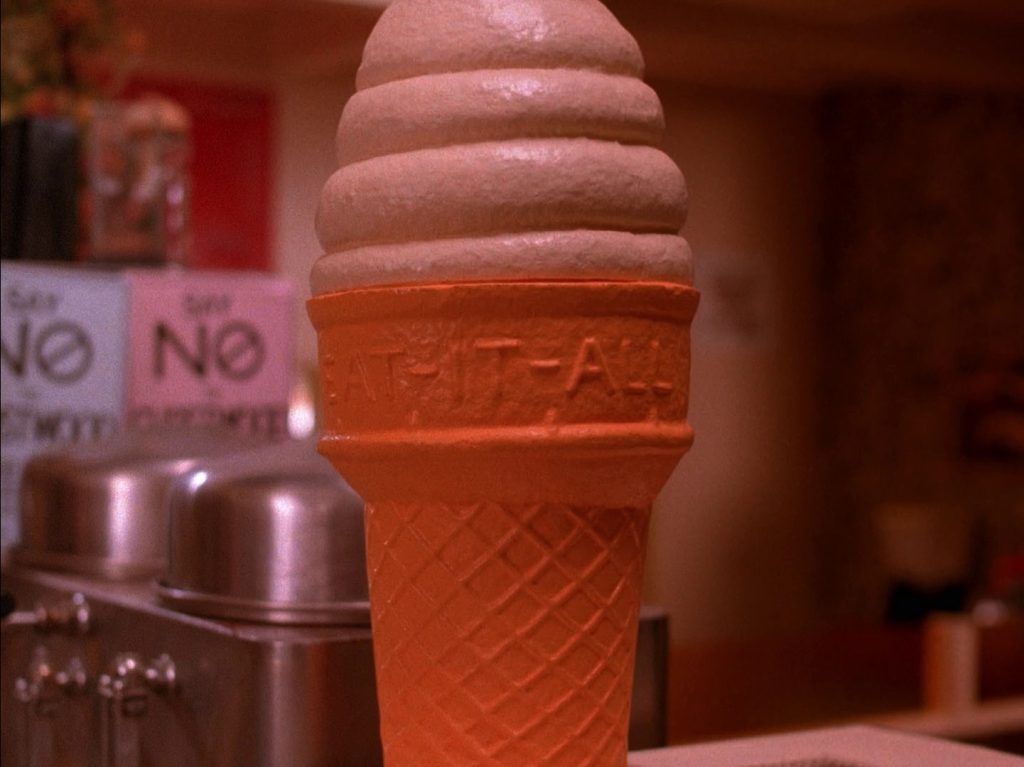
[Tim Hunter] This kind of thing came right off the set. The ice cream cone. The diner was actually the biggest set on the stage, as I recall. And, and it was the hardest to shoot. It was the hardest set to shoot. And, and perhaps because it was so, it was so big. It really was vast. So, you know, this is another thing that you run into sort of in television. It’s the kind of thing that you don’t particularly want to think about as a filmmaker, but you think about it when you’re on a tight schedule.
You know, often one one would rather have a compact set. Doesn’t mean that you have to keep things static, but people don’t have big distances to cover, so the action can be blocked and staged and filmed in a fairly compact area. Whereas on a large set where every time somebody has to make a cross, they have to go 12-feet or something and you have to deal with how deep the background is all the time.
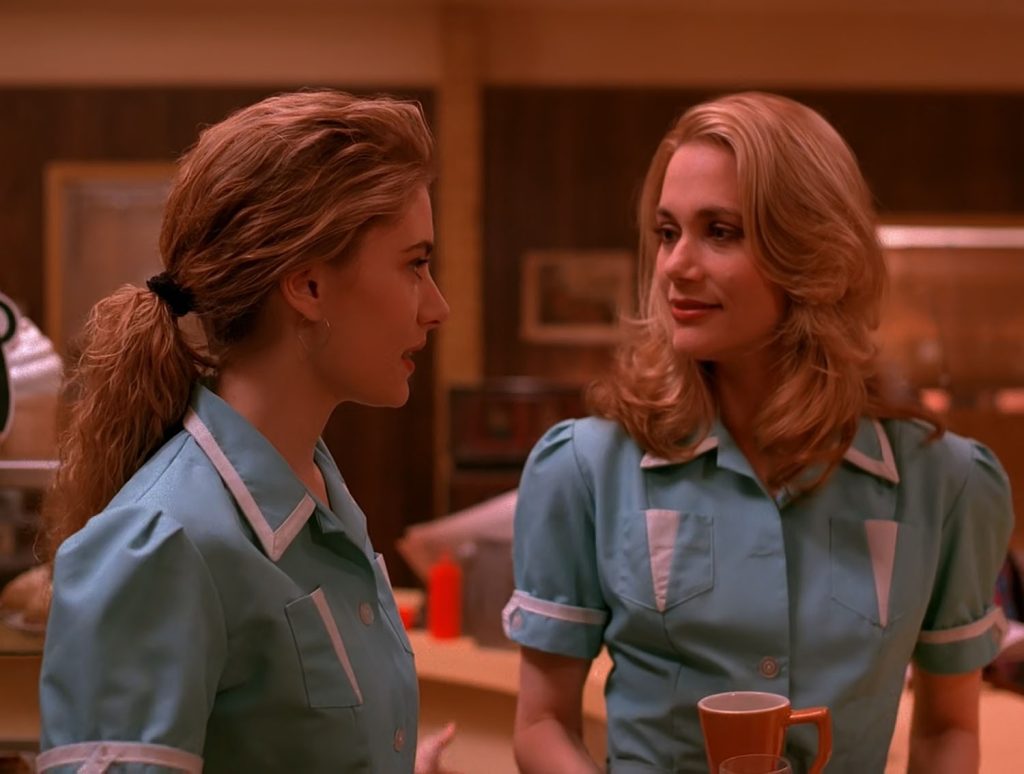
It was very hard to find an angle on this diner set. All of us felt it. We all approached the diner with some trepidation. In the same way that when I see a mirror, I. I go into [Douglas] Sirk-mode. When I see a diner, I go into Otto Preminger-mode and and, because I’m there’s a film of his called Fallen Angel. It’s just a film that I love as much as almost anything I’ve ever seen in the genre. And Fallen Angel has magnificent diner scenes, which, Preminger does very, very small camera moves. But that shift perspectives and balances in a major way. So I’m sure I must have been thinking of Fallen Angel day in the Twin Peaks Diner.
The setups are very functional and maximize their potential for getting as much action in them as possible, and the often have small moves that make big changes in the emotional flow of the scene. When I try to do in my style, which has never been particularly showy, but which is fluid, I think is, you know, as to, use the camera to underscore the changing emotions and the and the slow of scene.
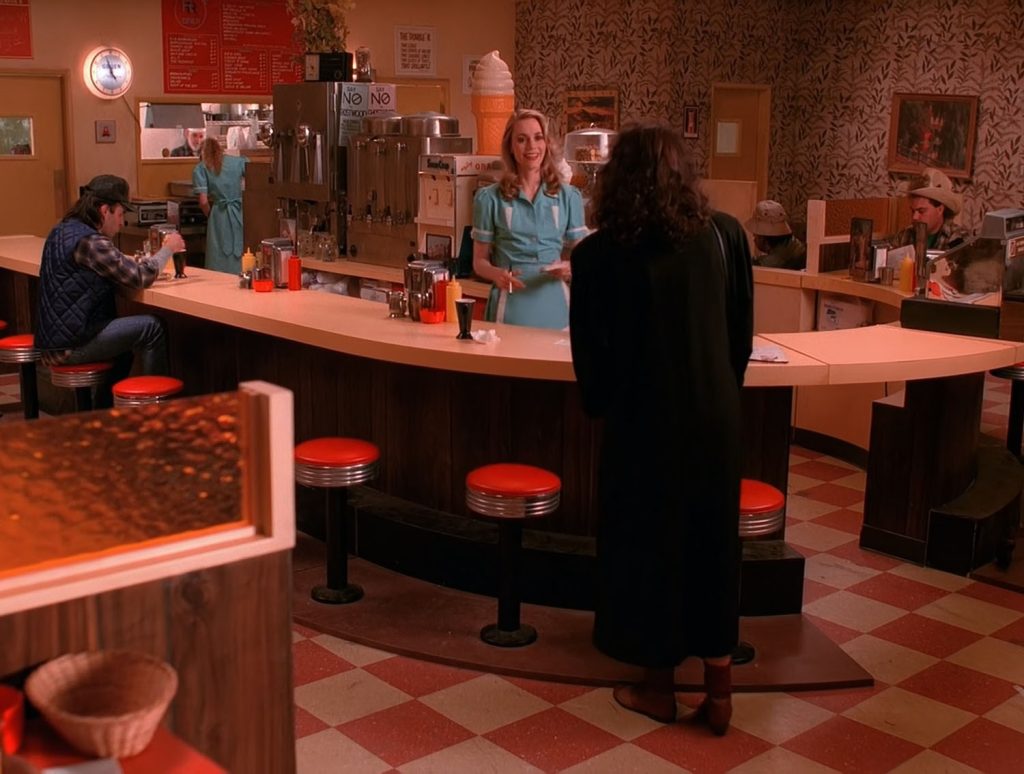
Off him on the phone and, you know, into a wide angle shot or something. That’s that in itself shows you how big the you thing is. What the hell I was trying to do here, but at least it’s precise.
[Bob Engles] I always think that Maddie’s appearance is so wonderful about this series. One of those things that really just completely solidifies how it why it works so well. Because it’s such a cliché to have a, dead twin arrive, and yet people just flipped and it’s like, in one sense, you would, it’s so obvious that we were doing that.
But it’s just such a, you know, it’s as David would say, it’s a beautiful thing when it happens. You can’t change that and it just worked. You know, the second that you just see what a great idea this was to bring this person that was just like it just sort. And if it’s all about guilt, that just ramped it up beyond, you know, so that once again, we took a, a cliché idea and twisted it so that it made the series wonderful.
Whereas, you know, if you were to see that on a, a lesser show. But it’s you think it’s good to think of something better. We never got that comment. We thought, oh, that’s delicious for that’s pretty ballsy to do that. Whereas if you do it, you know, Superman’s twin shows up, you know it’s a yawn. It was lucky that they that they hired a real actress to play Laura for that matter. And that’s really where the luck started because anyways, well, maybe she can do it. And then of course, she could. She was great.
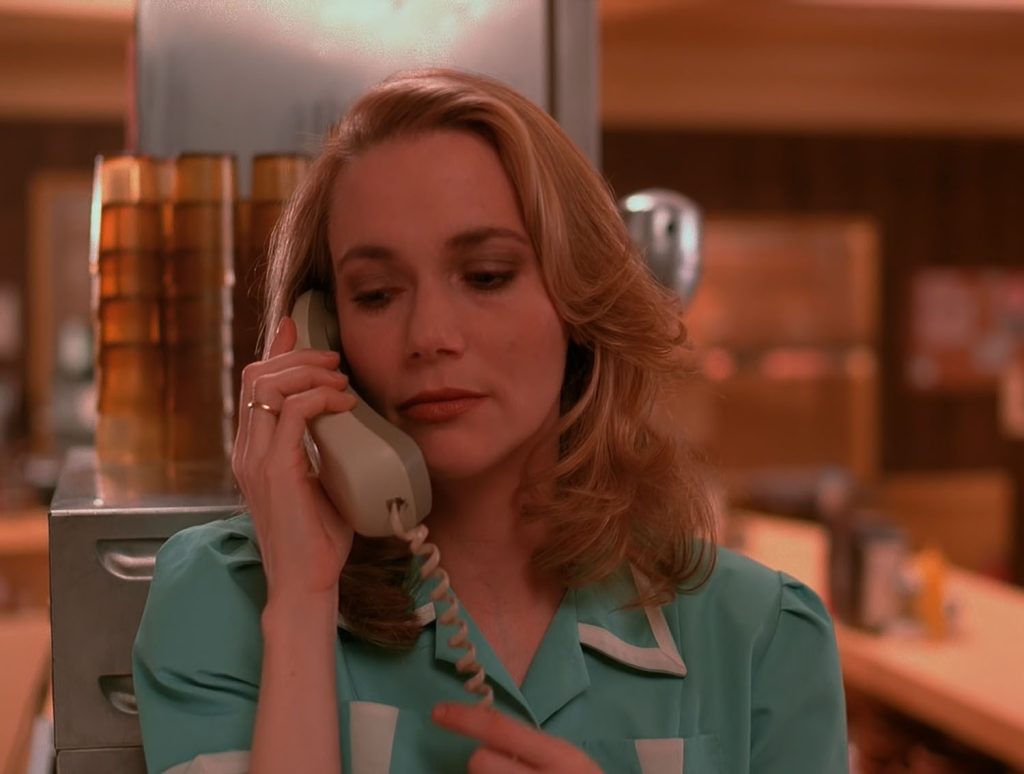
[Tim Hunter] I mean, I like a shot that shifts from one thing to another that goes from a close up to a wide shot and then dollies into something else. So much of television tends to be, you know, you tend to be forced to just kind of drawing stuff to the foreground, drawing the action to wherever the lens is in the most rudimentary possible way. And I always resist that when I’m doing a, a TV episode.
TWIN PEAKS – EPISODE 1.004 – ACT FOUR COMMENTARY

This was another case of a shot that came out of the set. I’m sure I positioned the bicycle there because I wanted to do this very symmetrical shot. I guess I saw the the antler chandelier and the swordfish. I did a pretty good gag with the swordfish in the next episode that I did. Also in the rug, so I guess I put them right in the middle of it.
Another thing that was interesting about Twin Peaks is that Angelo Badalamenti never scored any of the individual episodes. He wrote all the music cues before the season started and basically provided the series with, grew up to like almost 200 music cues, and whenever we asked him to write something for a scene, he would simply refuse to do it and send us off to the library. And we’d have to go through the cues and, and find something that fit the scene.
And this became kind of quite wonderful in a way, because they had a wonderful music editor named Lori Eschler, who’s credited in the corral, who became a very good friend of mine. And, Lori knew this music like nobody’s business. And she and all the directors worked very closely on finding cues to fit the episodes that had all been delivered to post-production before the season started shooting.
And we were all wound up doing stuff like, she would re-record cues half speed, she would re-record cue backwards. There was an enormous amount of editing, you know, between cues. There’s, there’s a queue at the end of this episode, actually, where I coming back to it distinctly remember that we put three separate cues together to build, to build the music track on the, on the scene.
So it became a joke that, that, nobody could get Badalamenti to ever write a cue for a specific scene. But we would, you know, and the big challenge for me working with Lori was always to, to find a cue in the library that nobody had used yet. That’s very unusual. You know, because usually even a TV show has a composer in residence that will score it, albeit very quickly, for the most part.
But, you know, every show has its Mark Snow or Mike post, you know who who scores every week. And, and here we just had a music library of, you know, Lori would come and say, “Well, here, here’s all the music for the second season.” You know, and it would be a box of, a box of DATs [Digital Audio Tapes].
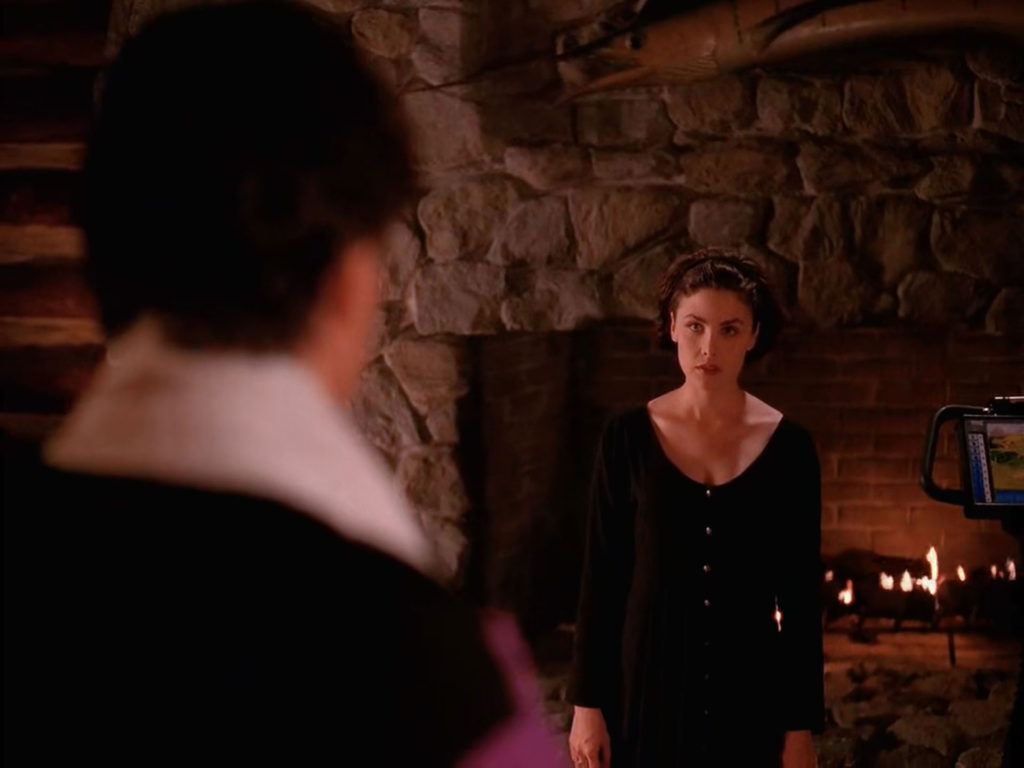
I’m looking at this now and remembering how much I like playing these people in close ups and, and dealing with a deep focus situation where the background was either in focus or out of focus. And the last shot in this scene, when he’s on the phone and he tells Audrey to, to take off, I think we must have used a split diopter to, to to keep it all in, in defocus. I remember using a diopter in the shot.

The show is wonderful for this because, you know, I have they always, you always knew they were thinking something other than what they were, what they were playing. So you could deal with the very honestly with the surface emotions, really push the surface emotions and still know that, there was a whole other subtext going on underneath the scene.
Yeah. This is a diopter shot. You can see the focus is, sort of blurred in the middle.

[Bob Engles] And of course you know wherever we go with the whole series it says “Twin Peaks Sheriff’s Department” and I think that’s incorrect. I think it’s the Sheriff’s Office, the Sheriff has an office and he works for a department. I think of that every time I see it and that’s forever. It’s the Sheriff’s Department but the sign should have said “Twin Peaks Sheriff’s Office.” And that’s what is says anywhere, it doesn’t say “department” anywhere.
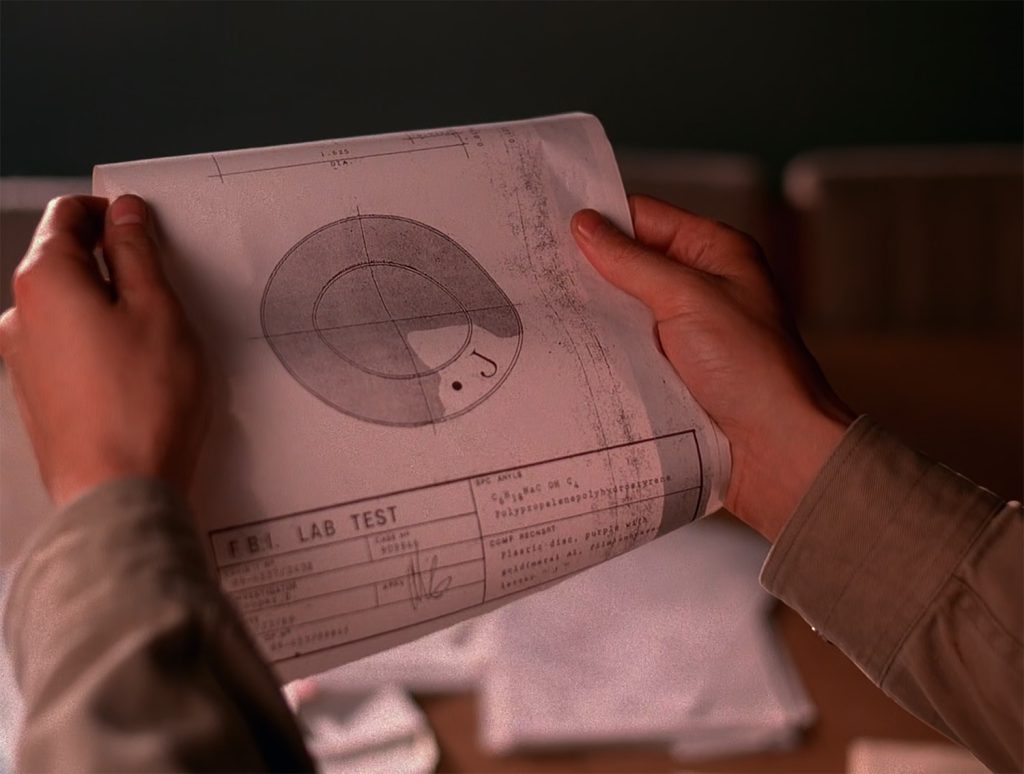
[Tim Hunter] To this day, I can’t figure out what One Eyed Jacks had to do with the storyline.
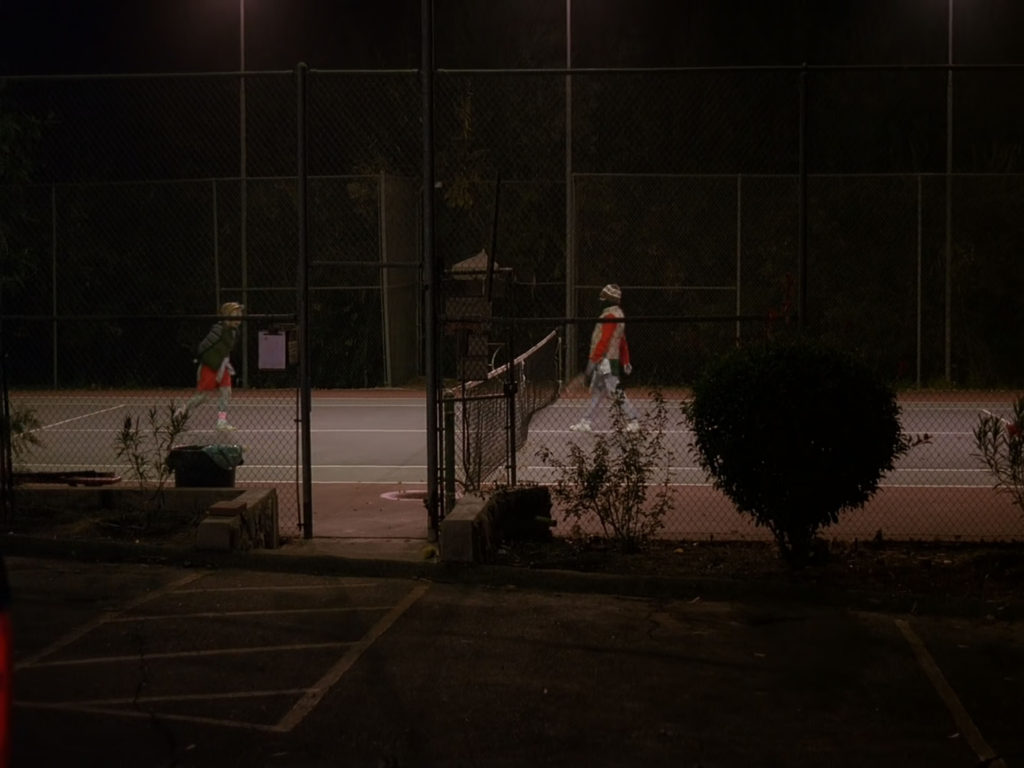
[Bob Engles] Here’s the other thing when you see those two people. In every one of the first seven [episodes], there is an odd extras. We did that very consciously. There’s the guys with the iron briefcases in one or you see those two people playing tennis. We did that, we spent extras more than enough time on.

[Tim Hunter] We had this apartment house and it has this tennis court so I asked if I could get a couple of extras playing night tennis. It seemed like we should use it. It seemed like “Twin Peaksy.” I forget where we shot this, it’s a great location. This apartment house in the middle of nowhere [ed. note – it was shot at the Malibou Lake Mountain Club in Agoura Hills, California].
[Bob Engles] It doesn’t seem so odd now, but when we made it, that was another thing people who are these people, what are these people playing tennis there? What are all those people dressed alike? What are the Icelandic people there, they are singing? Now, that’s the meat and potatoes of lots of series you know. But when we did it, no one had two people in winter clothing playing tennis with no particular attention to them, you know. None.

[Tim Hunter] Well at this point in the series, they were still sending crews up to Washington to pick up exterior shots for all the episodes, so the directors’ had an opportunity to request establishing shots or transition shot in the Washington location for their episodes. I remember for this episode 4, I had asked for the transition shot of water that proceeded that scene we did in Malibou Lake here.
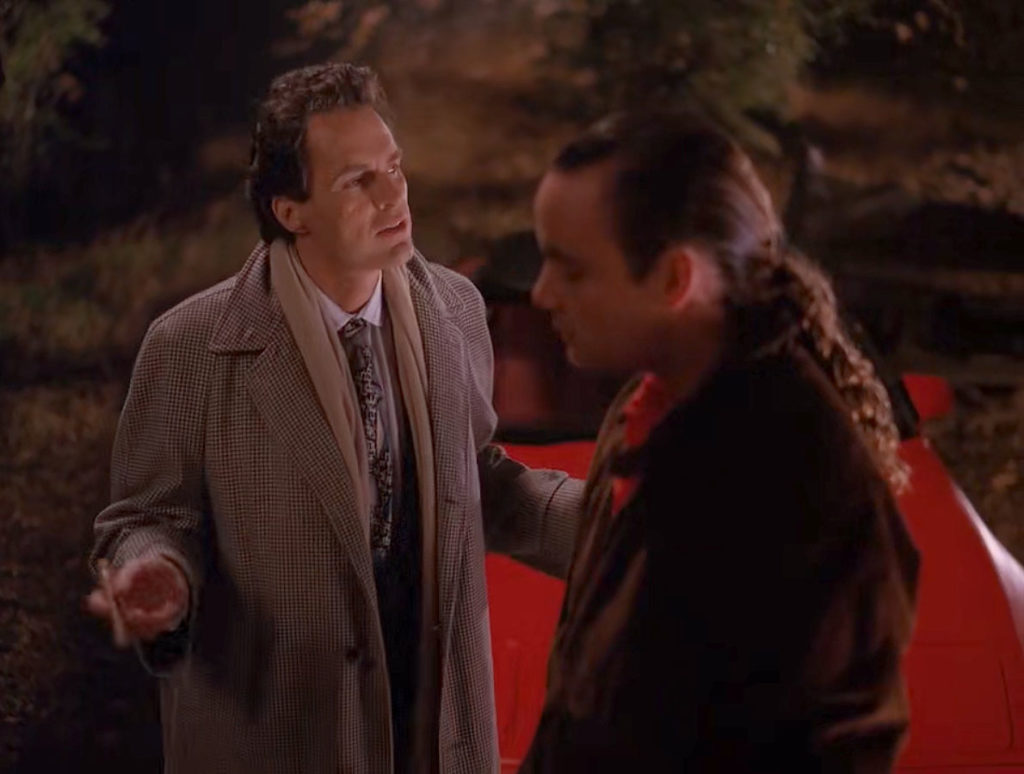
This was a nice location. I set up a big long track for this which starts as a lateral track then becomes Richard Beymer waking into his own point-of-view.
[Bob Engles] It has to be a Corvette. We had to have a Corvette. This is as good as can be. If you really want to see wonderful television and how to break the mold and still tell the story like a television story that’s supposed to be told, that was Twin Peaks. And you can sense that. In one sense, it was a huge surprise and in another sense you could sort of feel that we just had a whole different fan going, you know.
And I think until this day, what is quirky is defined by Twin Peaks. That’s a word that comes up all the time. I’m not sure what it means anymore but the idea that you could do off beat stories that people would watch and last and fall in love with. That’s really what it did and you know, you’d spawned a whole genre that didn’t exist, from Northern Exposure to Ed, there wouldn’t be Ed without Twin Peaks.
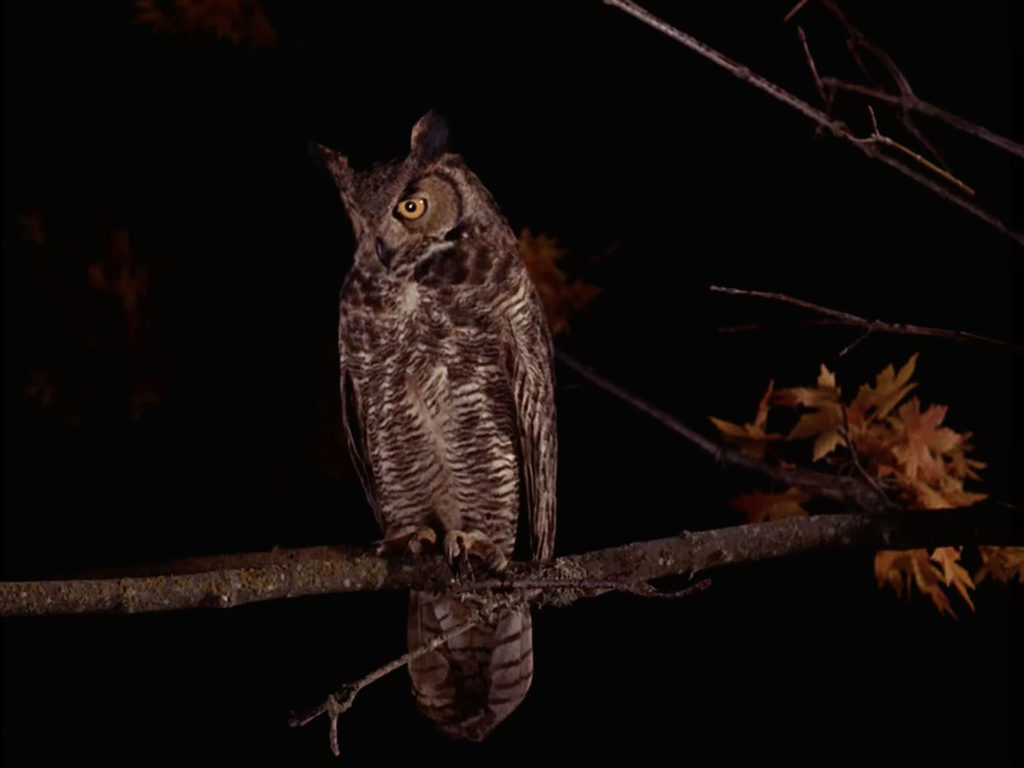
Ed would be Mayberry without Twin Peaks, you know what I mean? The sense that you could take about a guy owning a bowling alley and that’s it. And we’re going to watch it now. That wouldn’t be as interesting. Those creators would not have the freedom if David and Mark hadn’t done Twin Peaks because you know, in a weird way, it was so muscular.
It just sort of was what it was and you sort of had to watch it because of that. And I think that’s the, you know, that’s its influence. There just wasn’t anything like it visually on television.
[Tim Hunter] I like the last act of in this. It has a series of good climaxes in it. And seeing when they broke into the apartment, the night tennis scene. I remember wanting to stage as if it were the final scene of the act. Make it a little faster and a little more melodramatic, but then knowing that there would be two or three scenes after it that would extend the mood of mystery and climax but still taper it down.
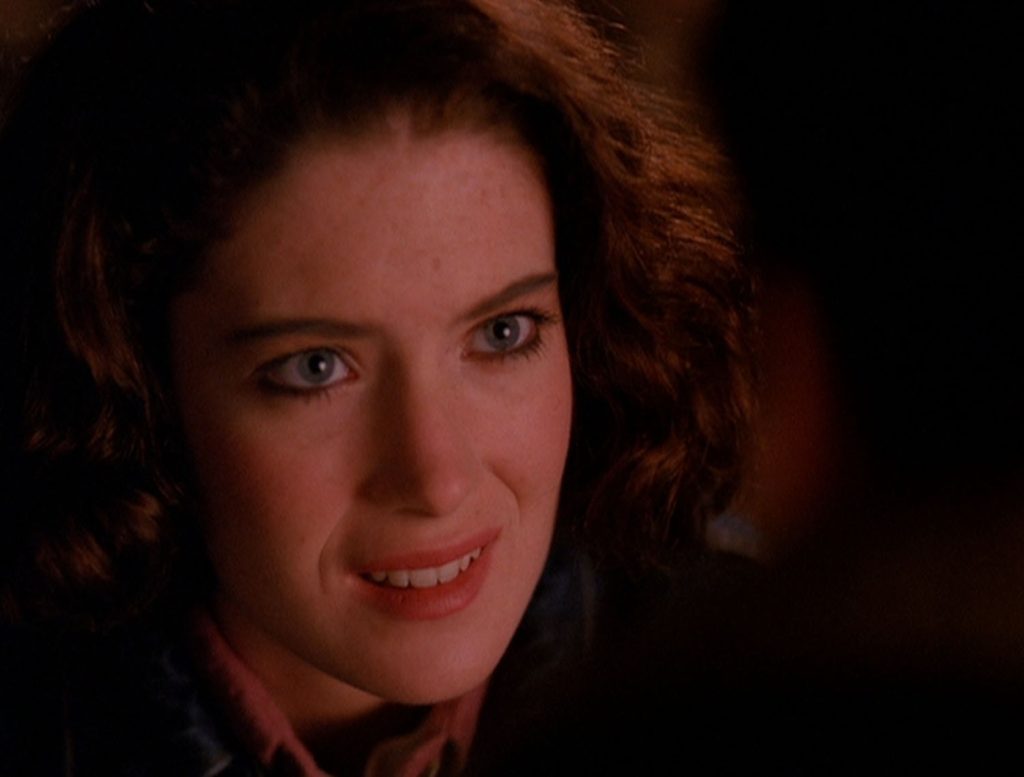
This is what I was saying about Lara Flynn Boyle. I tended to play her in close-ups just because of the way she says everything in kind of this hushed, anxious way that make you feel like she’s delivering some troubled intimacy.
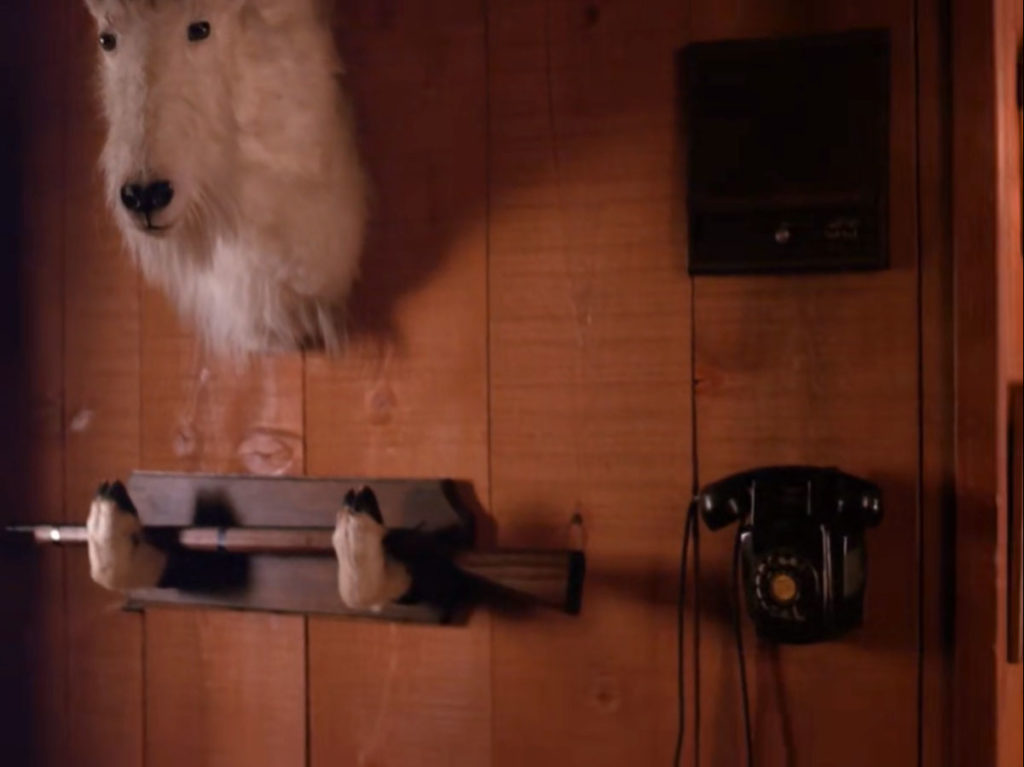
[Bob Engles] These sets are just wonderful. The sheep’s head and the hooves holding a gun. That’s remarkable and clever. You know, Richard Hoover who did the sets, you know, he’s won a Tony and and Emmy and nominated for an Oscar since this. But it was just so clever and tasty as opposed to let’s just do something really stupid. There was a fine line, you know, which didn’t happen very much in a show that was so sort of outrageous.
I think that Josie and Pete were supposed to be more together. I don’t think sexually but more together and that got lost or never gotten too I guess would be a better way to put it. And once at the end of the series the fire at the bank changes everything anyway. But that changed a lot of things. I don’t know why that got lost. A lot of it is you start to realize we got to keep the main story going.
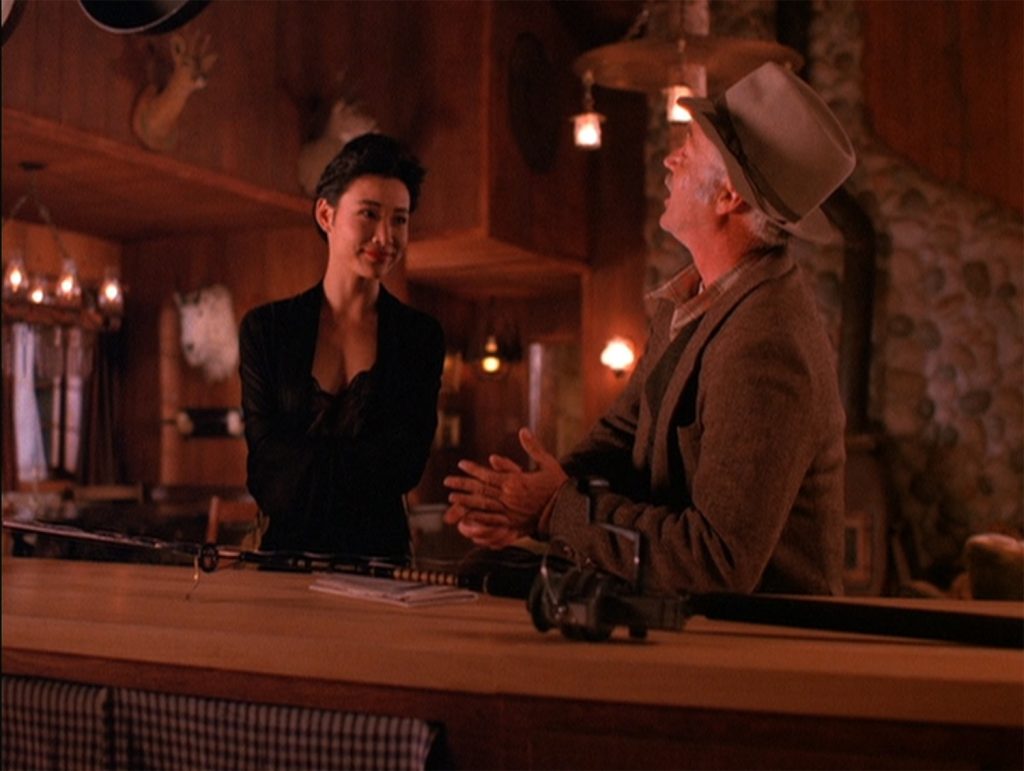
I think there are probably lots of threads that we didn’t get to or fiddle with and decided not to or you just didn’t have time. Or you realize we didn’t have him for that episode so that’s going to have to go away.
And I don’t ever recall that we were going to go to a fishing contest but we probably were [laughs]. There was probably some scene, you know, that was going to be about fishing.
Josie was supposedly to be, does feel like she was going to be a bigger figure but I think as things played out, some people you have to spend more time on the bench just by the virtue of trying to get the story out. And probably, as the length of the scripts diminished, the same thing happened – people’s characters suffer. I think Josie was supposed to be a bigger and was certainly bigger in [Twin Peaks: Fire Walk With Me]. And the planning of the movie was even a bigger part. We didn’t have time to play out as much. I think it’s more unlucky than planning.
I didn’t know Tim at all until he was going to do this episode. I know Tim was a classmate of David’s and a wonderful guy, great director. And Tim is the only guy David ever let shoot the Dutch angle. Usually those were forboden but Tim just got to do it. Oh, okay, one gets to do the Dutch angle.

[Tim Hunter] I think I used the Dutch angle here because it was the ending and the scene itself was fairly quiet. So I wanted an angle that would be just slightly unsettling.
[Bob Engles] In lots of ways, Tim was the, this would be just my opinion, Tim was closest to what David and Mark wanted. He was the easiest, came to it the easiest and just had a nice easy sense of how to do things. But this episode is also full of so many of the elements that the series was. It was kind of, it’s really loaded up.
[Tim Hunter] But then again, you were so free in Twin Peaks to figure out how to undermine the audiences’ expectations or make it a bit unusual. We were part of something so special.
Discover more from TWIN PEAKS BLOG
Subscribe to get the latest posts sent to your email.

